#its really cool to see how art shapes science!
Explore tagged Tumblr posts
Text
I was going to try to yap in the tags but it was too many characters, so for a bit of irrelevant commentary-- I'm personally fascinated by stories that follow semi-utopian societies in which a group of people has solved a bunch of problems caused by life under capitalism, but also thrown out a few desirable aspects of our current system as they built something entirely different. I think Ursula LaGuin's "The Disposessed" and Lois Lowry's "The Giver" do this especially well. (I've linked the Wikipedia synopses in case anyone is interested, though I would absolutely recommend reading both books!)
My tastes are partially driven by my politics (I really love stories that try to create realistic anarchist societies that maintain a level of technological sophistication similar to our own) but I think these stories are also just really engaging literature, because we get to explore the world through characters that take for granted things that we dream about, and dream about things that we take for granted. Because of this, they can avoid being prescriptive or preachy, and there's a pretty clear route to an interesting plotline as the characters dive into the non-ideal aspects of their organizational systems and try to rebel against or improve them.
I think solarpunk would lend itself really well to this sort of thing! What would it take, to unify people to create this sort of a future? What would we lose along the way? Even if we think these losses would be worth it, what would our great-great-grandchildren think as they are growing up in the world we've created? They should be allowed to complain about their world in a nuanced manner that recognizes that a broken utopia doesn't have to be cartoonishly oppressive. Work that criticizes aspects of a possible solarpunk future without reducing it to something monatonically bad would allow us to more clearly examine the flaws in our ideas and envision a realistic future.
(as a disclaimer, I'm not all that familiar with solarpunk so im not sure if this is coherent?? Also tagging @guutzprojects bc we were discussing similar ideas recently!)
I think a lot of the reason there's not been a ton of big solarpunk-style media is because it's inherently utopian and that leads to a real lack of conflict. Which is a shame that there's not a lot, because I LOVE how Solarpunk looks! But A lot of it is very big-scale from what I've seen; theorizing about ways man can integrate technology with nature, but not really what man is actually doing after that. What are the kinds of lives people would live in a solarpunk city? Surely actual human stories don't simply end because a lot of our needs are met. There's gotta be something!!
#yapping#hmm now i want to write this lmao#its really cool to see how art shapes science!#especially since ive largely engaged with The Future through a science research mindset recently rather than an artistic one#From the american perspective i think we really need a guiding light other than elon musks desire to dominate things#and the governments desire to hit X milestone faster than X other country#hopefully sci fi can continue to provide that for us!#ok ill get off my soapbox now lol
5K notes
·
View notes
Text
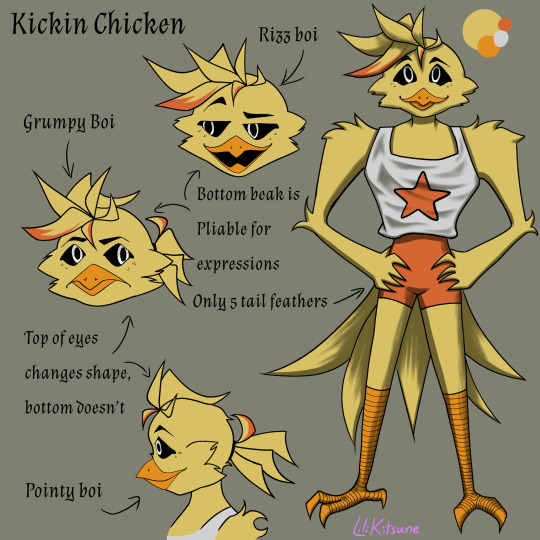
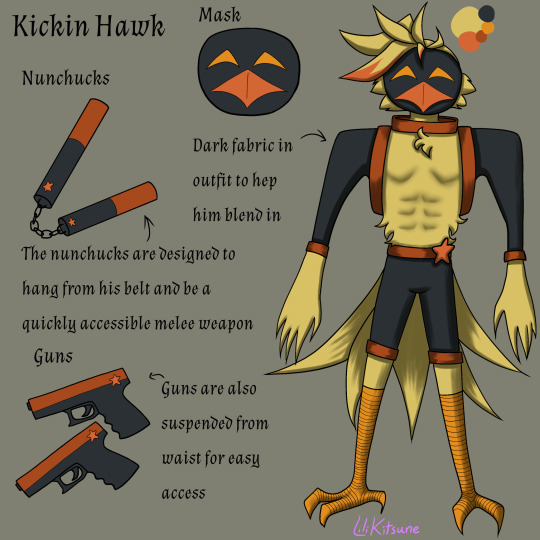
Officer it’s this one right here he crashed my drawing program and refused to cooperate
@neodracunyan here’s the criminal the one who broke my drawing program so bad I’m going to have to archive everything and clear its data again and it hasn’t even been 3 months since I last did that for spring cleaning. I love how he came out in the end but he crashed my program 5 times while I was working on him and has caused it to lag and crash constantly ever since. I adore this boi but I will always have hard feelings for his reference sheet. He looks so smug about it too.
Below the cut is my usual ramble as well as the sketches and shape study for this one. (He has taught me many things completely on accident)
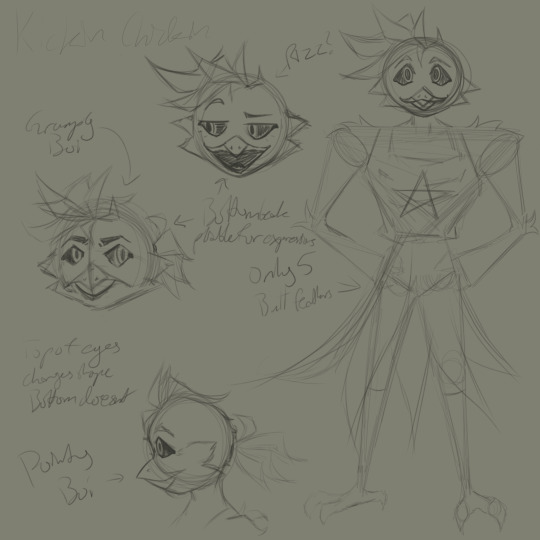
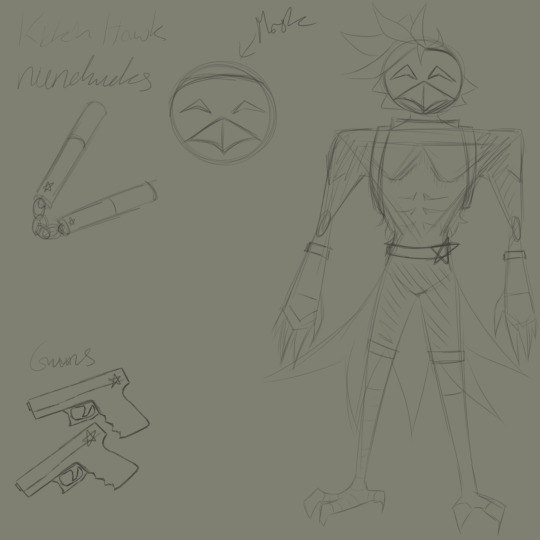

So let’s talk about this.
I started by sketching up a kickin that will never see the light of day fate just looking up my reference images and eyeballing it.
That kickin was really really ugly.
I know saying these things about one’s own art can seem degrading and derogatory but believe me when I say I got a second opinion and they agreed that chicken was ugly.
And they didn’t even know I was showing them my own art so I know it’s true.
So then I did the shape study and figured out why this wasn’t working the same as the others.
Then came a lot of trial and error of pushing different combinations of these shapes and builds together until I got a siluette that seemed to work (this was the one I used for the final version of kickin)
Then came the face which was also a matter with which I struggled but eventually figured out.
Despite all of these setbacks I do really like how kickin came out in the end (especially the side profile view) and once all of the struggles were through I really really ended up liking how he came out .
So let’s actually talk about this design now shall we?
Let’s start with the kickin hawk design. This design benefited from the fact that I knew who kickins partner is before choosing colors so I decided to make his grey clothing pieces blue toned in the same shade as bubba. It’s not super noticeable in the reference sheet because it’s surrounded by its complimentary and cross-complimentary colors (orange and yellow) making it look far more desaturated than it actually is. My intent is for the rest of the dark critters to have this same partnering motif from here on out in their color palettes (bubba will get kickins yellow, Bobby will get craftys cyan/teal color, and picky will get something green for hoppy) this will add a sort of visual synergy between each partner set making it more clear when they’re together as a group who the usual pairs are. (Instead of redoing catnap and dogday to fit this rule lets just say that their synergy thing is the red smoke bc when I designed them I didn’t know they were going to be put together as an individual pair instead of being with the rest of the critters as a group.) the idea for how kickin hawks weapons work is that they’re magnetic (either the holsters or a specific point on the weapon itself) and depending on which weapon it is will attach to a different point on his belt (think like polarity the nunchucks won’t attach to the spot where the guns go because the poles in its magnets don’t match the ones for the guns to attach to. This also means that if an enemy has a huge magnet they are guaranteed to never get all of kickins weapons because some of them will have opposing polarity and be repelled by the magnet instead of attracted to it a.k.a science is cool sometimes) The mask is for similar reasons to dogdays because of the fact that bubba uses lots of chemicals and gases similar to catnaps when fighting and kickin doesn’t want to deal with the loose gases effects (at that moment at least I feel like kickin would absolutely be bubba Guinea pig whenever he has a new variation to test) I also dyed some of his feathers with streaks of the reddish orange color because I feel like the moment he got the freedom to choose his appearance he’d go and change it. And uh yeah that’s about it for kickins ramble but if you have questions about the design choices feel free to ask ( while some of these guys may bite I won’t!)
#digital art#drawing#digital illustration#new drawing#artists on tumblr#fanart#smiling critters#kickin chicken#smiling critters au#would you believe me if I told you that while I was struggling with this one I completed another one of them#I’m thinking about releasing that one on Friday#so stay tuned bc at this point I think I’m just going to end up doing the rest of them
22 notes
·
View notes
Text
John Egbert, The Chess Grand Master's Girlfriend
(page 422-423)
8/1/2009 Wheel Spin: Parent Bad :( (again) Verdict: STILL VERY INCORRECT
These pages introduce a whole bunch of new concepts, but make a lot more sense when read side by side with page 251, which has already hinted at these (making Act 2 feel really well planned out). A lot comes together this way so this is 1300 words of Lore Discussion.
The Seven Gates - These appear to be the seven blue spirographs we pass through in first person POV on page 422, and also the blue spirographs that appear above John's house on page 251. These look like some kind of stepping stones (in-game achievements?) on the path to Skaia.
The number seven hasn't appeared in Homestuck yet, but in Western culture it is seen as a lucky number, and in Christian numerology it symbolizes perfection and evokes the seven days of creation, as well as the seven deadly sins. There are seven notes in a musical scale, and we know the characters are musicians, seven colors in the spectrum of light, and color appears to be symbolically relevant, and seven is the average roll for two six-sided dice, which are very commonly used in board games and tabletop roleplaying games.
Skaia - A spherical blue place covered in clouds with a white spirograph/flower shape in the center - perhaps made of pure sky, due to the name and its transparency. Of course, Sburb was created by Skaianet Systems, so its designers have some ties to this place. Its associations with height, sky, light and potential clearly relate it to the Christian concept of heaven. However, it's also referred to as a 'dormant crucible,' with a crucible being a scientific or alchemical container that can withstand extreme heat, used in historical metalwork and modern laboratories. The science and religion dichotomy is here to stay.
Nannasprite refuses to say what the 'unlimited creative potential' of Skaia means, because she won't give spoilers, but I immediately think of creativity = art. All the characters have hobbies that relate to creating and consuming different types of art, but for the most part they're not very good at it and/or don't have great taste. Skaia being something that unlocks their artistic potential - but at the same time, being something they have to put in a lot of work to reach, just as getting good at art takes practice - is very cool to me. However this could also relate to biblical creation, similar to the seven gates = seven days.
Skaia is 'untouched by the flow of time' and has so I absolutely think that people at Skaianet Systems accessed the creative power of Skaia and used it to create a video game that went far beyond the standard capabilities of technology, and that this power is the secret to their success (and how an unknown company made such a smash hit game on their first try).
Forces of Light & Darkness - Sburb is a classic good vs evil narrative, represented by the black and white pieces on a chessboard. Again on page 251, we see the flashing white/black/blue kernelsprite divide into not two but three parts - a white part that ascends, a black part that descends, and a blue part that remains with John. It's possible that these three parts all share knowledge via the game engine, explaining how Nannasprite knows so much about what's going on overall. She then becomes the bridge between the good faction, the evil faction, and the player whose arrival changes the game.
Seeing Skaia as artistic creation is interesting here, because it's exclusively associated with the forces of light/good. In the real world it's definitely possible for art to be used for evil, to attempt to manipulate people and intentionally spread negative and harmful messages, or just to mistreat the people who create it. In Homestuck, forces of darkness 'covet the destruction' of creativity (according to Nannasprite), which is a closer parallel to arts in the real world being underfunded and undervalued, with capitalism forcing people to work long hours at jobs where they're not able to stretch their creative muscles and that don't leave any time or energy for creative hobbies. The metaphor definitely works, but I'm really curious on if Homestuck will explore the idea that art isn't necessarily a perfect universal good.
Curtains/Stage - The many layered red curtains in page 422's animation share a design with the red curtains on page 247, marking the end of act 1. This positions the curtains/acts as representing different locations - John's house on Earth, Skaia in the Medium, likely others, perhaps corresponding to scene changes on a stage that need to happen behind a curtain. Nannasprite also uses the word 'stage' to describe the setting of a duel between light and darkness, coding Homestuck and/or Sburb as a theater performance.
Chessboard - So there's a 1986 musical called Chess, and I think any parallels are probably coincidence, but it's still fun to think about just due to the chessboard on page 423. The story is a metaphor for the Cold War, represented by a US and Soviet chess champion (which from an American perspective at the time were the forces of light and dark, although in the modern day I do not personally share this assessment). A Hungarian/English woman dates both of these chess grand masters at separate times, who tries to calm their rivalry and is simultaneously manipulated by it.
At the time, musicals were not seen as an intellectual artistic medium, and creator Tim Rice was explicitly trying to create a more literary musical that would be taken more seriously, which is similar to how Homestuck is expanding the possibilities of a webcomic. Also notable from Wikipedia: the original set designer (who was replaced due to illness) 'had planned a "multimedia" show, with an elaborate tilting floor, banks of television monitors, and other technological touches.' I'm going to look for a recording of Chess and see if there's any further comparisons worth making.
John's Role - Yesterday, Nannasprite said that the Incipisphere came into being via John's computer, but also stands independently of it and always has. Today, Nannasprite says that the forces of light and dark have dueled forever in eternal stalemate until John showed up. This was confusing to me until I realized it's exactly how video game worlds work - they 'come into being' when a player installs them and begins playing, but at that point the characters and world already have extensive history. No matter the story, there's no way for any faction within the game to 'win' or for certain key things to happen until the player takes action. The player character's arrival into the game is typically the inciting incident that spawns a new chain of events, beginning to change the course of the narrative.
John's arrival changing everything doesn't necessarily mean that he specifically is a fated hero, just that he's the player character. He probably has a choice of paths to follow in the game, and can choose whether to ascend to Skaia and fight alongside the forces of light, or descend to the weird smoke below his house and fight alongside the forces of darkness, either way ending the stalemate if he succeeds. I wonder what the morality mechanics are in Sburb, and how they correspond to John's echeladder.
If I was to wildly theorize, I'd say that if John fights alongside the forces of light, reaches Skaia and beats the game, he'll be able to draw from that 'dormant crucible of unlimited creative potential' to not only undo the destruction of Earth, but also to create Homestuck itself, and release this work on the day his adventure originally began (as he's now outside the flow of linear time) instead of releasing the Sburb beta. This would bring a lot of meta elements of the story full circle, would help explain the multiple layers of commands and commentary in Homestuck, and would make our world's story and John's story into one consistent narrative. If done well, I think that could tie everything up very neatly.
#homestuck#reaction#hm. i know an internationally ranked chess player. i should prepare some questions for whenever i next see him#theory#chrono
15 notes
·
View notes
Text
welcome to the good times
(i hope, anyways)
hello! i'm theriverpointace :D url comes from where my extended family calls home + me being ace. you can call me river or ace :P
i'm not legally a minor but i still kinda consider myself one + aroace + sex-repulsed = no sex please! thanks <3
this is rather a fandom-centric blog, but which fandom depends on the day haha. (i'd add what i'm currently posting about but i don't trust myself to update this very often haha. figure it out <3) however it is not exclusively fandom! you'll see some other silly cute stuff too. and the occasional Horrors i'm sure.
tagging system:
#talk tag: this is when i make an original post in conjunction with that, my #ask tag is for asks! #riverpoint art: art #riverpoint writing: my writing and also me talking about my writing projects #friend tag: my friends <3 #for ángel: tag for my girlfriend who i love very much so i reblog posts for aer so ly has nice things to look at bc i don't get to talk to star v often :(
my projects! i'm not necessarily working on all of these all the time but i do love to turn them over in my head :) also at the time of my writing this i haven't posted about. any of these. yet. but i really really hope to soon!!
the half-crown royals: my science-fantasy steampunk rewrite of the story of the trojan war in defense of paris of troy
the newsies unexpected powers au: a newsies au where they live in a little village and have random powers and go about their daily lives with such powers. generally more wacky (apothecary shenanigans) but has its serious moments (lab rats)
the postapocalyptic theban senator villain arc: i was recently in a small-town college production of sophocles' antigone (trans. don taylor) that was set in a punk-rock postapocalyptic thebes! i had a lot of fun building my character and shaping her backstory for the show, and as we struck the set, i began thinking about what happens to her afterwards ... and decided that she learns absolutely nothing from creon's arrogance and downfall.
idk those are the big ones. for right now at least. i love them so much. i have another couple smaller ones that, much as i love them, just haven't been as fleshed out. (helen and dean, the war orphans, the pirates, the villain protag zak, and two different groups of superheroes. and then probably some others. yk how it goes.)
anyways that should be that! i love making friends so feel free to reach out if you think i post about cool things!
4 notes
·
View notes
Text
Let's Talk Divination
This was originally going to be a much more specific post, but I decided to take in in a different direction. Today, I'm going to cover divination as a general topic, including how to practice it.
Like my post on ritual magic, let's get started with a definition. What exactly is divination? Merriam-Webster nails it, I think:
"The art or practice that seeks to foresee or foretell future events or discover hidden knowledge, usually by the interpretation of omens or by the aid of supernatural powers."
I dig this definition a lot. It tells us that:
Divination is both an art and a science
It is both natural and supernatural
It can be used to uncover information
It can be used to tell the future
That's all well and good, but why is divination important? Let's take a look at those last two points there: uncovering information and foretelling the future.
Uncovering information spans a wide range of applications. Did you misplace your phone? A crude map of your home and a pendulum can help you remember where it is. Had something go worse than you were hoping? A tarot spread can help you examine why.
Foretelling the future seems self-explanatory, but it's more complex than that. Divination can certainly tell you likely outcomes, but it won't set your fate in stone. If anything, it's part of being a proactive force in your own destiny.
Alright, cool. We have some ways divination helps us out. But how do we practice it? The good news is, that's up to you!
If you're new to the skill, I suggest starting with a pendulum. These are great because they're portable, versatile, discreet, and easy to make. All you need is about 8-10 inches of string and a small weight to tie onto the end.
To use a pendulum, hold it by the non-weighted end and let it swing freely. Before divining, I tend to ask my pendulum to signal to me the following:
Yes
No
Maybe
Answer unknown
That helps me calibrate the pendulum so I can clearly understand its responses.
If you're less comfortable with freeform interpretation, there are plenty of divination mats to try. Some are simple, others are more complex and mimic spirit boards. I encourage you to make a couple out of paper and see if you like them before purchasing one.
Mastered the pendulum? Try something a little more complicated, like Elder Futhark or Ogham. These are rune sets that are rich in symbolism but easy to make and learn. You can use wooden coins, index cards, or anything of regular size and shape to make your own and get started.
Runes not really your thing? Or maybe you've mastered them too? In this case, I can't recommend Lenormand highly enough. It's a 36 card deck with beautiful, easy-to-understand art on every card. The best part? Each card has a playing card equivalent; you can purchase a set of poker cards and draw your own!
Where do we go from here? I'd say oracle decks! These are unique in that they're non-standard. Each deck is highly personal to its creator and differs from all others. I suggest doing a lot of research to find one you like, and really taking the time to learn its methods and meanings. A good oracle deck will carry you very far.
And now we come to the final divination method I'll discuss here: tarot. I kept this one for last because I consider it the hardest to learn.
Despite the consistent 78-card requirement (22 Major Arcana and 56 Minor Arcana), there is considerable variation between decks. Finding one you like seems impossible at times, and trying to find resources can be a pain if you're not reading a RWS or one of its variants.
But don't let that get to you. Finding a good tarot deck and learning at least the Major Arcana will net you a lot of experience in divination. Is it any more rewarding than the other methods? No, not really. But besides the pendulum, it's my favorite.
Are these the only divination methods available? Absolutely not. Geomancy, augury, bone-casting...the list goes on. There are as many ways to divine as there are people divining—and I didn't even cover scrying, which is a topic all on its own.
Give these methods a try! Let me know how they work for you.
As always, blessed be~
3 notes
·
View notes
Text
What are the 7 Elements of Interior Design?
Interior design is both an art and a science that focuses on enhancing the interior of a space to achieve a healthier and more aesthetically pleasing environment. To create a balanced and harmonious interior, designers rely on the seven core elements: space, line, form, light, color, texture, and pattern. Let’s dive into each of these elements to understand their significance in interior design.
1. Space
Space is the foundation of any interior design. It is the physical boundaries within which the designer works. Space can be divided into two types: positive space (the areas filled with furniture or décor) and negative space (the empty areas that provide visual rest). A well-balanced use of space ensures that a room does not feel cluttered or too sparse.
2. Line
Lines are responsible for creating forms and shapes within a space. They provide a sense of direction and guide the eye around a room. Lines can be horizontal, vertical, or dynamic (curved or angled). The careful use of lines can help establish harmony, contrast, and unity in an interior.
3. Form
Form is the shape of the room and the objects within it. It can be geometric (man-made) or natural (organic). To create visual interest, designers often use a mix of different forms that complement each other. When selecting furniture or decorative items, consider their form to ensure they fit well within the overall design.
4. Light
Light plays a crucial role in setting the mood and functionality of a space. There are two types of light: natural and artificial. Proper lighting enhances the color, texture, and patterns in a room, contributing to its overall ambiance. Whether it is task lighting for a study area or ambient lighting for a cozy living room, light must be well-planned.
5. Color
Color affects how a room feels and can create a variety of moods. Cool colors like blue and green can make a space feel calm and refreshing, while warm colors like red and yellow add warmth and energy. Choosing the right color palette is essential for bringing all elements together cohesively.
6. Texture
Texture refers to the tactile quality of surfaces. It can be visual (how something looks like it feels) or actual (how it really feels). A good mix of textures, like a soft rug paired with a rough wooden table, adds depth and interest to a room, making it more inviting and engaging.
7. Pattern
Patterns add life and movement to a room. They are created by repeating designs or shapes and can be found in wallpaper, fabrics, and rugs. Patterns should be used thoughtfully to avoid overwhelming the space. When chosen correctly, patterns can enhance the room’s visual appeal and tie different elements together.
How Makhijas Group Can Help with Your Interior Design Needs
Makhijas Group specializes in providing comprehensive interior design solutions for residential properties. By leveraging their expertise, you can achieve a cohesive and well-balanced design that incorporates all seven elements effectively. They offer personalized consultations to understand your unique preferences and needs, guiding you through the entire process — from concept to completion.
Moreover, Makhijas Group ensures your home is a reflection of your personality and lifestyle, using these fundamental principles to create spaces that are not only beautiful but also functional and comfortable.
Get Expert Interior Design Help Today! Don’t leave your home’s design to chance! Contact Makhija Group to schedule a consultation and see how we can turn your vision into reality with a perfect blend of color, light, texture, and more.
1 note
·
View note
Text
“They can see themselves shaping the world they live in”
New Post has been published on https://thedigitalinsider.com/they-can-see-themselves-shaping-the-world-they-live-in/
“They can see themselves shaping the world they live in”


During the journey from the suburbs to the city, the tree canopy often dwindles down as skyscrapers rise up. A group of New England Innovation Academy students wondered why that is.
“Our friend Victoria noticed that where we live in Marlborough there are lots of trees in our own backyards. But if you drive just 30 minutes to Boston, there are almost no trees,” said high school junior Ileana Fournier. “We were struck by that duality.”
This inspired Fournier and her classmates Victoria Leeth and Jessie Magenyi to prototype a mobile app that illustrates Massachusetts deforestation trends for Day of AI, a free, hands-on curriculum developed by the MIT Responsible AI for Social Empowerment and Education (RAISE) initiative, headquartered in the MIT Media Lab and in collaboration with the MIT Schwarzman College of Computing and MIT Open Learning. They were among a group of 20 students from New England Innovation Academy who shared their projects during the 2024 Day of AI global celebration hosted with the Museum of Science.
The Day of AI curriculum introduces K-12 students to artificial intelligence. Now in its third year, Day of AI enables students to improve their communities and collaborate on larger global challenges using AI. Fournier, Leeth, and Magenyi’s TreeSavers app falls under the Telling Climate Stories with Data module, one of four new climate-change-focused lessons.
“We want you to be able to express yourselves creatively to use AI to solve problems with critical-thinking skills,” Cynthia Breazeal, director of MIT RAISE, dean for digital learning at MIT Open Learning, and professor of media arts and sciences, said during this year’s Day of AI global celebration at the Museum of Science. “We want you to have an ethical and responsible way to think about this really powerful, cool, and exciting technology.”
Moving from understanding to action
Day of AI invites students to examine the intersection of AI and various disciplines, such as history, civics, computer science, math, and climate change. With the curriculum available year-round, more than 10,000 educators across 114 countries have brought Day of AI activities to their classrooms and homes.
The curriculum gives students the agency to evaluate local issues and invent meaningful solutions. “We’re thinking about how to create tools that will allow kids to have direct access to data and have a personal connection that intersects with their lived experiences,” Robert Parks, curriculum developer at MIT RAISE, said at the Day of AI global celebration.
Before this year, first-year Jeremie Kwampo said he knew very little about AI. “I was very intrigued,” he said. “I started to experiment with ChatGPT to see how it reacts. How close can I get this to human emotion? What is AI’s knowledge compared to a human’s knowledge?”
In addition to helping students spark an interest in AI literacy, teachers around the world have told MIT RAISE that they want to use data science lessons to engage students in conversations about climate change. Therefore, Day of AI’s new hands-on projects use weather and climate change to show students why it’s important to develop a critical understanding of dataset design and collection when observing the world around them.
“There is a lag between cause and effect in everyday lives,” said Parks. “Our goal is to demystify that, and allow kids to access data so they can see a long view of things.”
Tools like MIT App Inventor — which allows anyone to create a mobile application — help students make sense of what they can learn from data. Fournier, Leeth, and Magenyi programmed TreeSavers in App Inventor to chart regional deforestation rates across Massachusetts, identify ongoing trends through statistical models, and predict environmental impact. The students put that “long view” of climate change into practice when developing TreeSavers’ interactive maps. Users can toggle between Massachusetts’s current tree cover, historical data, and future high-risk areas.
Although AI provides fast answers, it doesn’t necessarily offer equitable solutions, said David Sittenfeld, director of the Center for the Environment at the Museum of Science. The Day of AI curriculum asks students to make decisions on sourcing data, ensuring unbiased data, and thinking responsibly about how findings could be used.
“There’s an ethical concern about tracking people’s data,” said Ethan Jorda, a New England Innovation Academy student. His group used open-source data to program an app that helps users track and reduce their carbon footprint.
Christine Cunningham, senior vice president of STEM Learning at the Museum of Science, believes students are prepared to use AI responsibly to make the world a better place. “They can see themselves shaping the world they live in,” said Cunningham. “Moving through from understanding to action, kids will never look at a bridge or a piece of plastic lying on the ground in the same way again.”
Deepening collaboration on earth and beyond
The 2024 Day of AI speakers emphasized collaborative problem solving at the local, national, and global levels.
“Through different ideas and different perspectives, we’re going to get better solutions,” said Cunningham. “How do we start young enough that every child has a chance to both understand the world around them but also to move toward shaping the future?”
Presenters from MIT, the Museum of Science, and NASA approached this question with a common goal — expanding STEM education to learners of all ages and backgrounds.
“We have been delighted to collaborate with the MIT RAISE team to bring this year’s Day of AI celebration to the Museum of Science,” says Meg Rosenburg, manager of operations at the Museum of Science Centers for Public Science Learning. “This opportunity to highlight the new climate modules for the curriculum not only perfectly aligns with the museum’s goals to focus on climate and active hope throughout our Year of the Earthshot initiative, but it has also allowed us to bring our teams together and grow a relationship that we are very excited to build upon in the future.”
Rachel Connolly, systems integration and analysis lead for NASA’s Science Activation Program, showed the power of collaboration with the example of how human comprehension of Saturn’s appearance has evolved. From Galileo’s early telescope to the Cassini space probe, modern imaging of Saturn represents 400 years of science, technology, and math working together to further knowledge.
“Technologies, and the engineers who built them, advance the questions we’re able to ask and therefore what we’re able to understand,” said Connolly, research scientist at MIT Media Lab.
New England Innovation Academy students saw an opportunity for collaboration a little closer to home. Emmett Buck-Thompson, Jeff Cheng, and Max Hunt envisioned a social media app to connect volunteers with local charities. Their project was inspired by Buck-Thompson’s father’s difficulties finding volunteering opportunities, Hunt’s role as the president of the school’s Community Impact Club, and Cheng’s aspiration to reduce screen time for social media users. Using MIT App Inventor, their combined ideas led to a prototype with the potential to make a real-world impact in their community.
The Day of AI curriculum teaches the mechanics of AI, ethical considerations and responsible uses, and interdisciplinary applications for different fields. It also empowers students to become creative problem solvers and engaged citizens in their communities and online. From supporting volunteer efforts to encouraging action for the state’s forests to tackling the global challenge of climate change, today’s students are becoming tomorrow’s leaders with Day of AI.
“We want to empower you to know that this is a tool you can use to make your community better, to help people around you with this technology,” said Breazeal.
Other Day of AI speakers included Tim Ritchie, president of the Museum of Science; Michael Lawrence Evans, program director of the Boston Mayor’s Office of New Urban Mechanics; Dava Newman, director of the MIT Media Lab; and Natalie Lao, executive director of the App Inventor Foundation.
#000#2024#ai#Algorithms#Analysis#Analytics#app#applications#apps#artificial#Artificial Intelligence#Arts#bridge#carbon#carbon footprint#challenge#change#chart#chatGPT#climate#climate change#collaborate#Collaboration#collaborative#college#Community#comprehension#computer#Computer Science#Computer science and technology
0 notes
Text
“They can see themselves shaping the world they live in”
New Post has been published on https://sunalei.org/news/they-can-see-themselves-shaping-the-world-they-live-in/
“They can see themselves shaping the world they live in”

During the journey from the suburbs to the city, the tree canopy often dwindles down as skyscrapers rise up. A group of New England Innovation Academy students wondered why that is.
“Our friend Victoria noticed that where we live in Marlborough there are lots of trees in our own backyards. But if you drive just 30 minutes to Boston, there are almost no trees,” said high school junior Ileana Fournier. “We were struck by that duality.”
This inspired Fournier and her classmates Victoria Leeth and Jessie Magenyi to prototype a mobile app that illustrates Massachusetts deforestation trends for Day of AI, a free, hands-on curriculum developed by the MIT Responsible AI for Social Empowerment and Education (RAISE) initiative, headquartered in the MIT Media Lab and in collaboration with the MIT Schwarzman College of Computing and MIT Open Learning. They were among a group of 20 students from New England Innovation Academy who shared their projects during the 2024 Day of AI global celebration hosted with the Museum of Science.
The Day of AI curriculum introduces K-12 students to artificial intelligence. Now in its third year, Day of AI enables students to improve their communities and collaborate on larger global challenges using AI. Fournier, Leeth, and Magenyi’s TreeSavers app falls under the Telling Climate Stories with Data module, one of four new climate-change-focused lessons.
“We want you to be able to express yourselves creatively to use AI to solve problems with critical-thinking skills,” Cynthia Breazeal, director of MIT RAISE, dean for digital learning at MIT Open Learning, and professor of media arts and sciences, said during this year’s Day of AI global celebration at the Museum of Science. “We want you to have an ethical and responsible way to think about this really powerful, cool, and exciting technology.”
Moving from understanding to action
Day of AI invites students to examine the intersection of AI and various disciplines, such as history, civics, computer science, math, and climate change. With the curriculum available year-round, more than 10,000 educators across 114 countries have brought Day of AI activities to their classrooms and homes.
The curriculum gives students the agency to evaluate local issues and invent meaningful solutions. “We’re thinking about how to create tools that will allow kids to have direct access to data and have a personal connection that intersects with their lived experiences,” Robert Parks, curriculum developer at MIT RAISE, said at the Day of AI global celebration.
Before this year, first-year Jeremie Kwampo said he knew very little about AI. “I was very intrigued,” he said. “I started to experiment with ChatGPT to see how it reacts. How close can I get this to human emotion? What is AI’s knowledge compared to a human’s knowledge?”
In addition to helping students spark an interest in AI literacy, teachers around the world have told MIT RAISE that they want to use data science lessons to engage students in conversations about climate change. Therefore, Day of AI’s new hands-on projects use weather and climate change to show students why it’s important to develop a critical understanding of dataset design and collection when observing the world around them.
“There is a lag between cause and effect in everyday lives,” said Parks. “Our goal is to demystify that, and allow kids to access data so they can see a long view of things.”
Tools like MIT App Inventor — which allows anyone to create a mobile application — help students make sense of what they can learn from data. Fournier, Leeth, and Magenyi programmed TreeSavers in App Inventor to chart regional deforestation rates across Massachusetts, identify ongoing trends through statistical models, and predict environmental impact. The students put that “long view” of climate change into practice when developing TreeSavers’ interactive maps. Users can toggle between Massachusetts’s current tree cover, historical data, and future high-risk areas.
Although AI provides fast answers, it doesn’t necessarily offer equitable solutions, said David Sittenfeld, director of the Center for the Environment at the Museum of Science. The Day of AI curriculum asks students to make decisions on sourcing data, ensuring unbiased data, and thinking responsibly about how findings could be used.
“There’s an ethical concern about tracking people’s data,” said Ethan Jorda, a New England Innovation Academy student. His group used open-source data to program an app that helps users track and reduce their carbon footprint.
Christine Cunningham, senior vice president of STEM Learning at the Museum of Science, believes students are prepared to use AI responsibly to make the world a better place. “They can see themselves shaping the world they live in,” said Cunningham. “Moving through from understanding to action, kids will never look at a bridge or a piece of plastic lying on the ground in the same way again.”
Deepening collaboration on earth and beyond
The 2024 Day of AI speakers emphasized collaborative problem solving at the local, national, and global levels.
“Through different ideas and different perspectives, we’re going to get better solutions,” said Cunningham. “How do we start young enough that every child has a chance to both understand the world around them but also to move toward shaping the future?”
Presenters from MIT, the Museum of Science, and NASA approached this question with a common goal — expanding STEM education to learners of all ages and backgrounds.
“We have been delighted to collaborate with the MIT RAISE team to bring this year’s Day of AI celebration to the Museum of Science,” says Meg Rosenburg, manager of operations at the Museum of Science Centers for Public Science Learning. “This opportunity to highlight the new climate modules for the curriculum not only perfectly aligns with the museum’s goals to focus on climate and active hope throughout our Year of the Earthshot initiative, but it has also allowed us to bring our teams together and grow a relationship that we are very excited to build upon in the future.”
Rachel Connolly, systems integration and analysis lead for NASA’s Science Activation Program, showed the power of collaboration with the example of how human comprehension of Saturn’s appearance has evolved. From Galileo’s early telescope to the Cassini space probe, modern imaging of Saturn represents 400 years of science, technology, and math working together to further knowledge.
“Technologies, and the engineers who built them, advance the questions we’re able to ask and therefore what we’re able to understand,” said Connolly, research scientist at MIT Media Lab.
New England Innovation Academy students saw an opportunity for collaboration a little closer to home. Emmett Buck-Thompson, Jeff Cheng, and Max Hunt envisioned a social media app to connect volunteers with local charities. Their project was inspired by Buck-Thompson’s father’s difficulties finding volunteering opportunities, Hunt’s role as the president of the school’s Community Impact Club, and Cheng’s aspiration to reduce screen time for social media users. Using MIT App Inventor, their combined ideas led to a prototype with the potential to make a real-world impact in their community.
The Day of AI curriculum teaches the mechanics of AI, ethical considerations and responsible uses, and interdisciplinary applications for different fields. It also empowers students to become creative problem solvers and engaged citizens in their communities and online. From supporting volunteer efforts to encouraging action for the state’s forests to tackling the global challenge of climate change, today’s students are becoming tomorrow’s leaders with Day of AI.
“We want to empower you to know that this is a tool you can use to make your community better, to help people around you with this technology,” said Breazeal.
Other Day of AI speakers included Tim Ritchie, president of the Museum of Science; Michael Lawrence Evans, program director of the Boston Mayor’s Office of New Urban Mechanics; Dava Newman, director of the MIT Media Lab; and Natalie Lao, executive director of the App Inventor Foundation.
0 notes
Text
Im going to interject here that i met students in one of the smithsonian field programs and they were just carrying a baby sloth around like "what we're localized like that" and its like where does it end youre supposed to be field biologists or is it a veterinary program (its not)
Anyway go ahead and test on any mammalian skulls you want i guess but theres no magic shrinkydink temperature, and human skulls arent magically different
I mean microplastics werent even a thing in "headshrinking times" so like pfft
See no outsider wants to test this really because theyre all caught up in the wonderment of collecting these heads themselves (literally like its in the smithsonian article) ...obviously some people are like "oh my i wouldnt like to be dead by gruesome means and seeing someone elses severed head reminds me of gruesome death" and thats why they shelve the whole topic of shrunken head truthing. Theoretically you could do so out of respect for the nominal practitioners, like self-reported as they purportedly are, i guess? I'm just sensing illusionists, as in practitioners of a different art than head shrinking, somewhere in this information pipeline
Whats the science here, it makes the bone jelly and the jelly melts down skull shaped and then you haul it out and cool it down and put the skin back on? How hot are they getting this water? Exactly?? Someone start boiling down the roadkill, i think you need a kiln
But it has to be exactly before it has lost integrity entirely too much...so like it has to get springy or spongy...and then it resolidifies? Smaller? I rrrrrrrrrrrreeeeeaaaallllllly want mythbusters on this
youtube
Like you gotta be using this thing right?
I just dont think bone does that you guys
Yes of course but what would i know if i havent boiled a bunch of mammal skulls over a forge at every possible temperature. Guess you have to keep adding water? This seems extremely silly
Like maybe this works on hooves?
0 notes
Text
Japanese Sword Production Lore As It Relates to Kimetsu no Yaiba – Master List
Master List of Teppi’s Adventures in Raw Sword Production
A very surface level look at transforming raw materials into something you can make a sword out of, looked at through the lens of KnY, with other tidbits of Swordsmith Village Lore throughout (especially names and names). This information is especially thanks to the Okuizumo Tatara Sword Museum (which has become a KnY hotspot for a black sword displayed there) and the Itohara Family Memorial, a historical iron making site. (Links shall be added momentarily) Part 1: Teppi is sent to Mt. Youkou and sees how Shoujouhi iron sand is gatheredPart 2: Teppi gets put to work on making charcoal and clay Part 3: Teppi helps build and work the Tatara furnace for three exhausting days Part 4: Teppi sees the general process from kera to katana
THIS HAS BEEN REVAMPED!!
PLEASE READ THE AO3 VERSION INSTEAD!!!!
Additional resources for nerds, KnY fic writers, or viewers who want to more deeply appreciate Nichirin blades (and Haganezuka says that should be all of you):
Please note, this is merely scratching the surface; it would be impossible to slice through all the Nihonto resources out there with a single starter list. I hope it covers a wide range of Nihonto topics helpful to both beginners and not-beginners. I am a not-beginner, but not at all any sort of expert whatsoever.
Text Based: An explanation of Nihonto and what makes them beautiful, written by the Former Senior Managing Director of the Society for Preservation of Japanese Art Sword & the associated Japanese Sword Museum. This society is best source for all things Nihonto related and a major reason we still get creative new blades to enjoy. This article is lengthy, but it’s the best place to start as a Nihonto nerd. A good glossary and diagrams of the different functional and structural parts of Nihonto Look, some jihada examples, pretty. Videos: A 10 minute, wordless overview of the Tatara process—basically what I’ve written about for Teppi but you get to watch it all unfold. A very ASMR video of sword polishing, to better appreciate Haganezuka’s battle in the Swordsmith Village Arc (includes English text in the video to explain some parts) Or, if you want the sword polishing process with English commentary (granted, it’s very dated sound quality): A beautiful video of basics of Japanese sword appreciation. Very clear and informative! …That is, if you speak Japanese. You can get auto-translations of the auto-generated Japanese subtitles, but those can be spotty. A much more detailed video, fully in English, taking apart the blade to better appreciate it. Excellent explanations both for beginners and not-beginners. Science! The light version explaining the curvature of a Japanese blade, with cool clips of the curve happening underwater. Science! The heavy version explaining the Hamon. I hope you like hearing about carbon. Oh, you want something more specific to Kimetsu no Yaiba? Was my conjecture not enough for you? Well, here’s a short one that’s been going around, proof of concept on the cutting ability of Inosuke’s sword, thank you, you excited nerds (Genya’s gonna be so upset about those watermelons though). And then when you’ve got a who-o-o-le lot more time on your hands, HOLY FUDGE, THIS GUY MADE IGURO’S SWORD. Not only that, he’s got video after video after video after video of the very, very, very extensive process of making the sword. You know what really blows me away? EVERY VIDEO HAS ENGLISH SUBTITLES AND THEY ARE GOOD. (Taisho Secret reminder from Chapter 190: Iguro’s sword was produced by Tecchikawahara’s son Gantetsu, with a special folding sheath that opens upward instead of drawing it out through the koiguchi (“carp mouth” because of its shape) like normal single-curve katana.) A note from a fanfic writer to other fanfic writers: There are no limits to nerdery. I fully encourage you to be a nerd. Go! Unleash yourself! Be a nerd! However, you can never assume that your readers have as much knowledge as you, or that they are there for a science or history lesson (though I assumed everyone who read Teppi’s adventure is here to learn). While being rich with details can draw people into your writing, don’t feel pressure to understand everything about a topic like Nihonto, because you don’t need to use everything in the topic. That daunting we don't need to do that to ourselves. Your readers are there for plot and characters (or lack of plot, even), so my advice is to use only as much detail as serves the readers’ enjoyment. Am I guilty of too much sword detail? Yes. Sometimes. I’m sure I am.
#kny nerdery#kny fandom theories and meta#SWORDS SWORDS SWORDS#by the way Nihonto is the catch-all phrase for Japanese blades#because katana is only one type
74 notes
·
View notes
Text
in general there’s a tier of science fiction antirealism that’s not even so much “rule of cool” as “rule of i resent even the vaguest suggestion of plausibility.” like, for example, mainline star trek has tons of silly ultra-soft sci fi elements in it, all kinds of phlebotonium and nonsense technobabble that exist just to move the plot forward. you can get kind of a rough picture of the shape of the universe, but god help you if you ever want to try to work out the actual distance between the klingon homeworld and earth, what warp factors or stardates actually correspond to, or what the prefix “iso-” is supposed to mean. some of this is on the order of normal continuity problems in long-running TV shows (how many decks does Voyager have? nevermind how many crew members), some of it is clearly just writers glossing over unimportant details--the difference between “warp 9″ and “warp 8″ don’t matter much, as long as you understand they’re both really fast, and warp 8 is slightly slower.
but there’s a tier several levels below that which is like... not only is the director or showrunner going to gloss over any unimportant details, they will hold in contempt even the thinnest veneer of an attempt to make the fictional world coherent. a great example is Abrams-trek, which is nominally approximately the same setting as base Trek. one of the planets-of-the-week in TOS was Delta Vega, a random remote planet far away from Earth that was the setting of the second pilot of the show. Not only is that name re-used in Star Trek, it’s reused for a planet close enough to Vulcan that from its surface the full disk of Vulcan is discernible, large enough that you can see Vulcan being destroyed with the naked eye.
this is patently ridiculous. not only can it not be the same planet, despite nothing in the movie indicating it isn’t, two celestial objects that close would gravitationally interact, to the point where either their orbits would be unstable, and they would cease being that close, or to the point where they’d be gravitationally bound, like the moon and the earth. although star trek has always been pretty soft sci fi, they’v cared enough about plausibility to often base plots on real-world speculative science, and to hire science advisors to bounce ideas off of. and while you can bend over backwards on fan wikis (and indeed Memory Alpha has) in that biblical-apologetics style that gins up alternate scenarios the on-screen action doesn’t explicitly contradict, this is plainly an after-the-fact patch up job.
the screenwriter in fact gives an explicit reason for these changes: the easter egg of the name was more important than the consistency, and while they could’ve had Spock watch Vulcan blow up through a telescope, this wasn’t considered cinematic enough.
and like... yes, moviemaking has an art to it, and sometimes plausibility and doing things in a particularly cinematic way have a tension between them. but it’s possible to prize storytelling style so far above storytelling substance that you actually end up with an incoherent story. i think i’m on record as saying prioritizing canon too much is a bad idea, but the problem here isn’t continuity errors within the larger star trek franchise as taking a science fiction premise, and then discarding fundamental elements of that premise (this is a universe which in most ways resembles our own, and functions according to realistic laws, whose major exceptions are flagged as such, either via technobabble or the characters’ own surprise at their existence), and holding that in contempt.
you can argue that impressionistic interpretations of cosmology for storytelling purposes 1) are nothing new, and 2) are tolerated by plenty of moviegoers who aren’t orbital mechanics anoraks. but there are plenty of things the average moviegoer doesn’t know, which we would nevertheless expect a filmmaker to get right. i don’t know much about the rank structure of the US army, but in a movie about the US army, i would not expect a colonel to give orders to a general, because that’s not how the army works. there is a rich vein of more impressionistic, fantasy-adjacent or even explicitly science fantasy works within the speculative fiction genre to draw on if you want to make that kind of movie. but (and this is my problem with the reboot movies generally) if you want to make a Star Trek movie, you probably shouldn’t make one that holds the fundamental premise of Star Trek in contempt.
this turned into a big rant about Abrams star trek, which is really not the only thing i have in mind here, just an especially handy example. i think there’s a big problem in the utilization of science fiction elements in stories, most especially in film, where because the realistic depiction of the astronomical universe isn’t something most people have an intuition for, screenwriters and directors feel like they’re not constrained by it when it comes to plausible storytelling. and while i think ordinary suspension of disbelief should be able to handle minor inconsistencies and stylistic flourishes if you’re a grown-ass adult, because requiring absolute literalism in all the media you consume is a little deranged, it’s a big problem when those inconsistencies become major plot points. planets hang out right next to each other in space. gas giants have solid surfaces. explicitly STL spaceships cross vast interstellar distances in mere hours or minutes. benedict cumberbatch is cast to play a south asian man. the problem is, if you do have even the roughest intuition for astronomical scales and how planets work, these errors crop up everywhere, and are as nonsensical as a World War 2 movie where Patton is a Nazi.
63 notes
·
View notes
Text
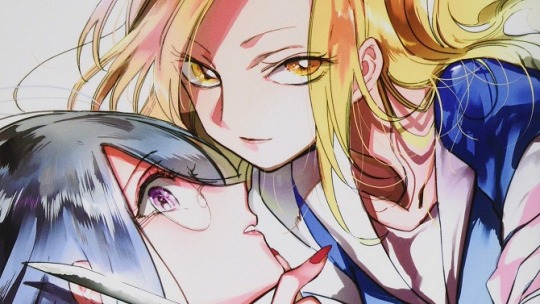
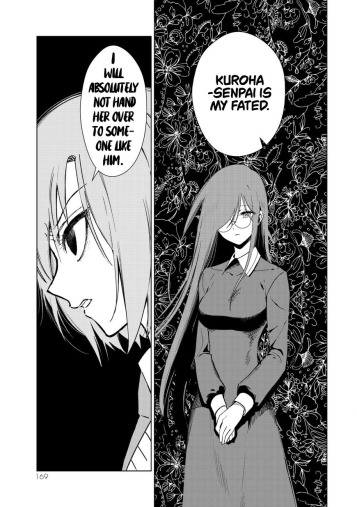
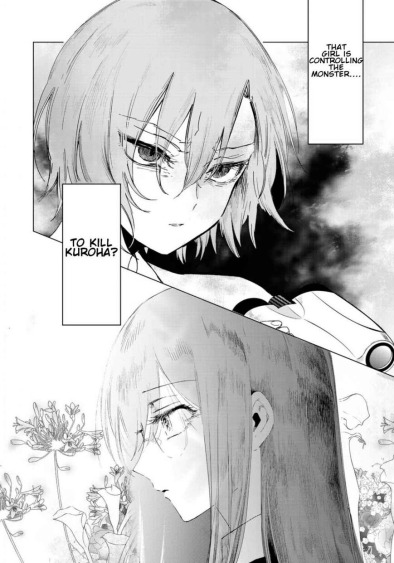
Kuroha to Nijisuke: Kuroki Majo no Divertimento (Manga)
Created by: Narita ryougo/Shiraume nazuna
Genre: Supernatural/Action
Cherry actually recommended this manga to me, and holy is it good. There's actually two parts to this manga, with Kuroha & Nijisuke, being a short prologue of this manga. The yandere and the male lead vaguely remind me of The Banished Villainess since they have the same qualities (both yanderes are "graceful", have a similar hairstyle and are of a sort of high status, where the two male leads are more rugged looking, strong and are very shy around the female lead), but the stories are very different from each other. This is one of those where I would read it for the story, and have the yandere as a bonus.
The story is about the two characters Kuroha and Nijisuke and their strange relationship with unluckiness and luckiness. Kuroha was born with extreme good luck, with the cost of having a monkey's paw effect -causing pain, suffering and bad luck to those around her, so much so that's she's dubbed a witch. Nijsuke on the other hand is the complete opposite. He's so unlucky as the universe wants him to die, but he's so strong that he's able to survive pretty much anything, from toxic smog to an entire truck ramming straight into him. He doesn't believe in luck whatsoever and believes that fate is in his own hands. Kuroha has the ability to see and converse with Shinigami, who deal with the dead souls of this town and are trying to take Nijusuke's soul and failing badly. It seems like Kuroha and Nijisuke's luck is causing a lot of the town to die, which leads to the Shinigami having more work to do. Kuroha is targeted by a medical group attempting to capture her and use her blood as a poison, and they hire the three Mitsugane sisters: Ai, the oldest and the one with the most experience in using science to get rid of body, Momo, the gyaru assassin and the youngest Midori, a huge and strong girl with a pure heart to get her. Meanwhile, the yandere, Kujinawa and his friend Benshima are trying to find a way to get rid of Nijusuke while protecting Kuroha. Kujinawa is able to see part of the Shinigami, meaning unlike Kuroha who seems them in their human form, he seems them in an abstract shape. All he knows is that when the shinigami are near someone, they die, and as a result of them being near Kuroha, he tries really hard to protect her using Benshima's help.Meanwhile, there are two killers, Kikuri, who is obsessed with the "art" of killing using the bodies to make morbid masterpieces and Shigari, a person who similar to Kujinawa can see the forms of Shinigamis and worships them through killing, believing that he is sacrificing to the Shinigami.
The story plot itself is really revolved around the pushing and pulling of the main two characters, Nujisuke and Kuroha, with different parties either wanting one dead or trying to use one's power. The dynamic of having a "lucky" person and an "unlucky" person is used to good effect in this story and a lot of the characters that are fighting for the two are connected with each other in one way or another. It can get a little convoluted since characters are introduced relatively fast, but its definitely a fun ride. It gets pretty bloody at times, which is surprising, but it makes sense as the entire story is about life and death, luck and unluckiness. Personally, I really do like all of the characters in the story as they all of their own motivations of doing what they're doing, from the CEO trying to gain Kuroha's blood to gain more poison, to the sisters working together to stay alive and even the two serial killers have reasons for killing. I think a lot of the characters are "unfortunate" in their own right, having had to deal with the situation that surrounds both Nujisuke and Kuroha and have to find different ways around the two just to get to where they need to be. It's really cool seeing how parts of the characters are connected to each other and the twist at the end was fun too, as there were hints to it initially. Both Nujisuke and Kuroha are great characters as well, with Nujisuke powering through the unlucky events through sheer willpower while also making his own fate, and Kuroha being cursed with her "good luck" and trying to live a better life with those around her. My favorite characters are probably the three sisters since they have a strong bond with each other and eventually even befriend Kuroha and Nujisuke. I like the tone of the story, having a good message while also having funny bits and action sprinkled in.
As for the yandere, Kujinawa, he doesn't really affect the story as much as other characters, at least, not in my eyes. The reason he liked Kuroha in the first place was that after he was able to see Shinigami, he fell into a sort of despair before seeing Kuroha being used by the Yakuza to gain money, he believed that the two were destined to fall together. For the most part in the story, he's responsible for saving/protecting Kuroha and the three girls from Shinigami, though he's also mistaken since Kuroha is extremely unlikely to die because of her good luck. The only major things he's really done are to save the girls from being killed by the serial killers and get them together in the building. Other than that, I do wish he had a more important role in the story, though it is noted that the story seems a bit rushed at the end, so it's possible that originally he was going to have more of a role, but he was sidelined so that the story could be finished. A pity considering he actually doesn't interact with Kuroha at all despite the fact that he's so in love with her. I wish the two had at least a moment together so we could see their interactions.
Still, though, I would highly recommend this manga if you like action, humor, and cute romance with tones of death. I really liked it, so thanks Cherry for recommending it to me!
#male yandere#yandere#yandere boy#recommendations#manga#completed#Kuroha to Nijisuke: Kuroki Majo no Divertimento
37 notes
·
View notes
Text

sims 4 holiday legacy!
i wanted to make a fun legacy with some silly rules to shake up the traditional goal based legacies! hope you enjoy it!
general rules:
- must complete aspiration, get to level ten of career, and complete extra rules to complete gen
- can use money cheats (if you want it to be traditional legacy, start with 1800 simoleans, if not, download a nice house and have starting funds)
- physical style/dress sense are suggestions, as you can have your sims look however you want
- everyone in household must have an excellent holiday for the holiday that correlates with the gen. if the holiday didnt come with seasons, add it to the calender!
gen 1: new years
as the first holiday of the year, youre ready to get your life, body, and mind into shape!
- traits: active, dog lover, perfectionist
- aspiration: bodybuilder
- career: writer (author)
- must always be dressed “fancy”
- silvery/platinum blonde hair
- max out fitness and writing skill. reach level five of wellness
- if you have the packs, include vintage glamour or luxury party in multiple rooms of your house
- whenever you are tense, must do yoga to cool off
- have a dog with active trait, go for jogs with them often
- only eat foods that you deem as healthy
- visit every gym lot in game (could do just premade ones and/or can add your own)
- marry a sim you met a gym or spa
- only publish motivational books or fitness
- have three friends that you go out with occasionally and party
- get “juiced” every holiday
gen 2: love day
youve been obsessed with romcoms and romance novels since you were a kid. now that youre grown up, you want to fulfill your childhood romance dreams!
- traits: romantic, bookworm, art lover
- aspiration: soulmate
- career: social media, either branch
- pink/red hair
- dress “romantically” (if you have seasons, use heart dress/suit)
- max charisma and painting skill
- must go on weekly dates with significant other
- gush about partner whenever option is avliable
- paint multiple portraits of partner using paint from reference
- only read romance novels and watch romantic tv
- if you have pets, must dress them in cute dresses
- live in the city as a young adult, can move after if you want to
- always go to romance festival
- have a boy and a girl
gen 3: talk like a pirate day
youve always loved the pirate lifestyle, exploring, stealing, and meeting people all over the place. eventhough you cant have a career as a pirate, that dosent stop you!
- traits: kleptomaniac, non-commital, self-assured
- aspiration: jungle explorer
- career: mixologist
- must wear a pirate outfit/hat as an everyday outfit
- max mixology and archeology skill. reach at least level four mischief
- have at least two children with different partners
- marry someone young, divorce, and never marry again
- have multiple boyfriends/girlfriends at a time
- always sell your artifacts and any other “treasure” you find
- complete at least four “plumages” (temples)
- attempt to steal something from every lot you visit
- for extra fun, if you use mc command center, max woohoo skill
- accept any party invite
gen 4: bunny day
you love being outside! in any weather, your family can expect to find you exploring outside in the garden, fishing, or finding some frogs
- traits: loves outdoors, unflirty, clumsy
- aspiration: angling ace
- career: fisherman and have a business (selling flower arrangements and mounted fish) or gardener (floral arranger)
- one outfit should be overalls
- green/purple hair
- this sim really likes hats
- max fishing and flower arranging. reach level 5 gardening and baking
- always talk about the current weather in every conversation
- if raining, shower in the rain instead of your shower
- have a large garden, but only grow flowers
- complete frog collection
- have a full fish tank in your house
- live in a tiny house
- purchase storm chaser and water resistant aspiration traits
- have one child
- become BFF with flower bunny
gen 5: earth day
the love your parent had for nature passed onto you. you want to make sure youre enjoying outside, while also protecting it!
- traits: green fiend, maker, gloomy
- aspiration: outdoor enthusiast
- career: eco innovator
- have green hair
- have a boho style
- live in either storage container or tiny home
- max herbalism and fabrication
- when you visit - must pick plain lot and sleep in a tent
- live off the grid and/or have surplus of energy
- have a large garden full of just fruits/veggies
- gift your herbal recipes to friends and family
- have bees and bugs
- have dumpster dived furniture in every room (once you unlock smog vaccum)
- one day a week do not eat a meal, only eat harvestables
- vote for a community garden maker space if living in evergreen harbour
- optional: can become a plant sim
gen 6: simspendence day
the party lifestyle is the lifestyle for you! friends, drinking, and fun is how you live your life! but you also make time to solve and end crime in your wonderful world!
- traits: dance machine, bro, jealous
- aspiration: party animal or island life
- career: detective
- red/yellow hair
- wears sunglasses often, even in cold weather!
- live in oasis springs
- any cooking you do must be on a grill or over a fire
- max guitar, dancing, and dj skill. reach level 4 fitness
- sing karaoke whenever theres a karaoke machine present
- have gold on every event type
- get suntans often
- ride bikes and kick soccer balls often
- have a large backyard with hot tub, fire pit, and water slides
- have two kids, have a good relationship with both. no parenting interactions though.
- watch sports tv only
- have five good friends (not including family). give two of them your house key
gen 7: prank day
what can you say? pranking is fun! messing with people and rilling them up is your favorite passtime.
- traits: goofball, ambitious, mean
- aspiration: chief of mischief
- career: engineer
- max comedy, mischief, and robotics
- always do a funny introduction to people
- use voodoo doll everytime you see the person it is bound to
- go to all dance parties you are invited to after 8pm and prank people
- create a servo
- marry someone that you had a bad relationship with originally
- you really like bowling. take your dates/family bowling often
- have a sad clown painting in your house
- if theres a microphone present, perform a comedy routine
gen 8: spooky day
youve always been obsessed with the spooky season and occult sims. now that you have your own house, its always spooky season!
- traits: loner, genius, neat
- aspiration: nerd brain
- career: astronaut
- black hair
- this sim wears glasses
- max rocket science, handiness
- befriend one of every occult
- can have a spooky house or just always have it decorated spooky
- must have at least one everyday outfit that is a “costume”
- always have carved pumpkins outside your door
- complete geode collection
- visit sixam at least three times
- have a child from a one night stand. do not marry that sim. marry an occult sim
gen 9: harvestfest
cooking has been an outlet for you since your parents let you near the stove. you love creating recipes for your family, friends, and even pets to try!
- traits: glutton, lazy, cat lover
- aspiration: big happy family or successful lineage
- career: own a vet
- yellow/orange hair
- wears mostly warm (tan, brown, yellow, orange) clothes
- max gourment cooking and vet skill
- have all 8 slots full (can include pets)
- must cook homemade pet recipes weekly
- have a little veggie patch for fresh ingredients
- befriend patchy
- whenever eating food not made by you, complain about the meal
- if you cook something less than excellent quality, throw it away and make a new dish, no matter how hungry you are
- get married twice
- rake leaves and then woohoo in them
- have family move nights schedules on the calendar!
gen 10: winterfest
winter is the best! the good food, cold weather, and constant family time is what life is all about!
- traits: family oriented, cheerful, materialistic
- aspiration: lady of the knits
- career: education
- blue/silvery hair
- wear lots of sweaters and cozy clothing
- max cooking and knitting
- give presents to family members everytime you see them
- keep a christmas tree in house year round
- must declare “snow” as favorite weather
- every day there is snow on ground, you must interact with it (snowball fight, shovel, snowpal, snow angel etc)
- have at least three children
- befriend father winter (can marry if you want to)
- complete snowglobe collection
- get the cold acclimation reward trait
- have a dinner party once every two weeks and cook a grand meal everytime
- have lots of family pictures in your house
- get the polar plunge player achievement (can make a holiday)
- always have a fireplace lit
#sims#sims 4 tumblr#sims 4 lets play#sims 4#sims gameplay#sims legacy#simblr#the sims 4#simblog#sims 4 challenge#sims 4 legacy#sims challenge
214 notes
·
View notes
Text
Steven Universe: End of an Era: Outline & Review
I wrote this review in October but never got around to posting it here
Steven Universe: End of an Era is far more than an art book–it’s also a collection of behind-the-scenes material, stories about the experience of working on the show, planning documents and associated background info, and both older versions of developed concepts AND concepts that never made it into the show. It's a huge fusion of all those elements, and it's definitely an experience!
Some low-quality images are included with my review just to give you an idea of what’s there--it’s not a good substitute for getting your own copy, but here’s a tour!

Like the previous concept art book, Art and Origins, I'll be giving you a description of the structure and overview, while also collecting notable information for fans. Obviously just about everything is "notable" once again, but I'll aim for unique insight or perspective on the main source material, keeping the screaming about everything new to a minimum so you can also enjoy something for yourself if you pick it up. My low-quality photos should prevent people from feeling like I'm reproducing the book in any capacity. Please grab one while you can and have your own experience!
[SU Book and Comic Reviews]
OVERVIEW
The book is titled "End of an Era" for a couple reasons--obviously because it is released after the show has wrapped, but also because Gem history recently ended its "Era 2" and began Era 3--an age of prosperity and peace. The author--the person in charge of adapting all of this information into this slick, readable package--is Chris McDonnell, whose work was previously applied on the Art and Origins book.
The foreword is by N.K. Jemisin, a well-known science fiction author who's a huge fan of the show (and wrote a really excellent series that also has a weird geological connection, by the way).
And the cover, like its predecessor, is shiny and decorated with a beach scene featuring minimalistic characters--this time it's the Gems at night in front of the Temple, and on the back cover is a big pink leg ship in a cross-legged pose.
The interior covers are decorated with tons of amazing sketches of Steven and Connie on the front, and a bunch of Gem sketches on the back. Every interior page that most would leave blank is highlighted with some kind of sketch art or character exercise--it's so much to look at, so much to absorb.
The book is dedicated "For Eddie."
Its organization is different from the previous book in that it shares applicable work in chunks associated with groups of episodes rather than pertaining to different aspects of building the show.
FOREWORD

N.K. Jemisin gives us such a great introduction to the book--apparently understanding very well that the audience of this book is full of animation enthusiasts and adult fans more than it is full of kids, and explaining that bewildering journey some adults had from blowing this show off as a silly kid thing to falling in love with it hard and fast.
The important thing, Jemisin says, is being able to trust a storyteller with your heart. And it was clear to her that Rebecca Sugar knew what she was talking about and was saying important things about identity and the radical power that comes with accepting it and demanding respect.
Important also is how we handle heroes and who gets to be one in fantasy. That's part of the reason Steven Universe speaks to so many--because we see ourselves here, and know stories can be about us. Acknowledging the power we all have to MAKE THINGS BETTER with what we fight for is so important--especially if we're going to speaking to the next generation about it.
Highlighting Rose Quartz as a "born leader" who failed and Steven as a relatable scamp who did what she couldn't, Jemisin asserts that we can save the world.
1. END OF AN ERA
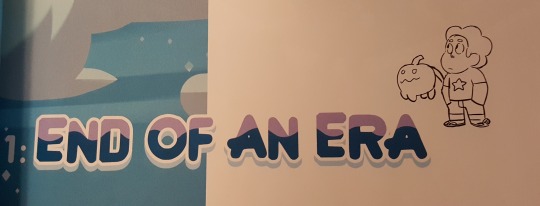
We start with an appeal to the audience to think about identity and the formative parts of our childhood--and how different it is if who you are and who you become is restricted, mocked, erased, or Not Allowed. Most people, if not ALL people, can relate to this, but for those of us with a special relationship with Steven Universe because of queer identity, this hits hard.
But it doesn't have to be anything grand to be something we respect--this show's authenticity comes largely from how personal everything is, drawn from real-life experiences and incidental truths from each artist's perspective, leaning hard on childhood and formative experiences.
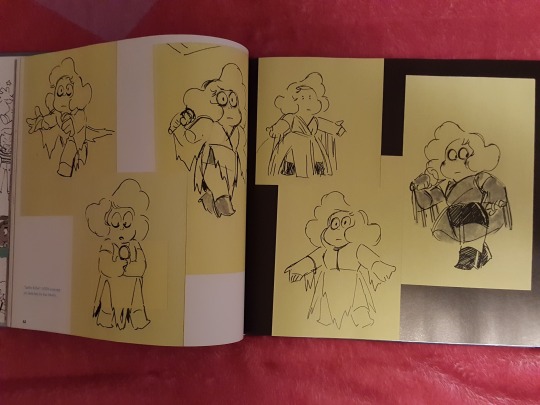
Rebecca Sugar offers some interview bits to discuss writing philosophy and why "writing female characters" was difficult for a nonbinary person who'd been socialized as a girl and a woman. Rebecca has spoken before about how frustrating it is that marketing for cartoons was SO gendered when she was growing up (and to some extent still is).
The Gems in the story are all "she/her," but on their planet they're defined by their work, not by emotion or relationships (unlike women in our society), so having them be socialized opposite to how she was and be able to claim those emotions through choice and NOT as just an expectation "as women" was revolutionary. Rebecca wants her show to tell all marginalized people that they don't deserve to be in the margins.
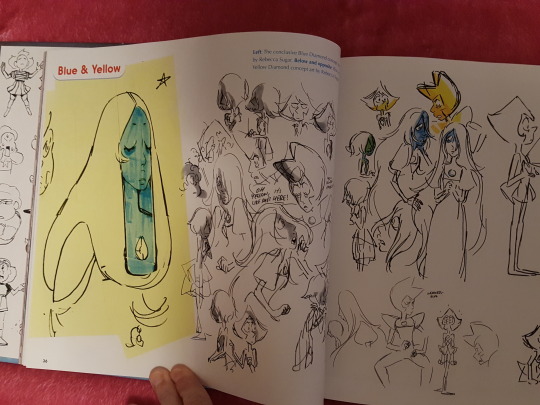
Weighing in on other aspects of the show were Ian Jones-Quartey, Joe Johnston, and Miki Brewster. Ian describes feeling like at first doing SU was a thrill ride that meant they'd finally get to do all the cool stuff, but it quickly became a responsibility that he took very seriously--the need to tell a good story now that he'd been given a megaphone.
Promotional art, planning documents, character sketches, and concept art from the lighthearted to the stone serious is included, along with some very cool (sort of famous) timeline charts that track major characters' developments. It's emphasized by Rebecca that the developmental materials ARE NOT CANON (and especially are not MORE canon) compared the final show.
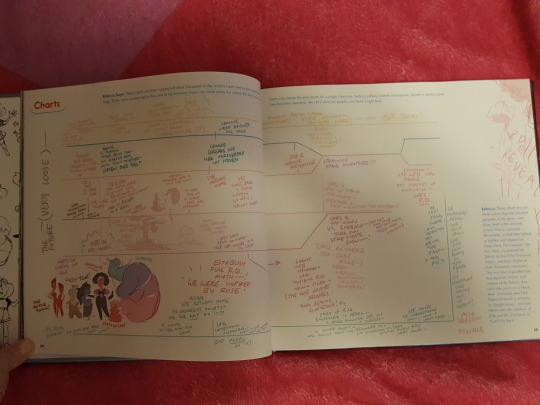
There are concept sketches alongside final art for Aquamarine and Topaz in "Wanted" (with Topaz labeled "Imperial Topaz"), the Zircons in "The Trial," Blue and Yellow Diamond, and the Off Colors (including Pink Lars).
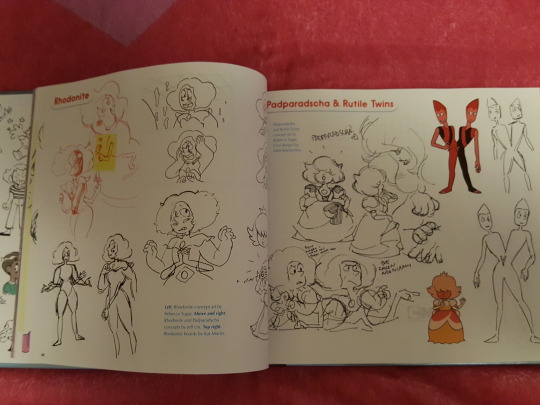
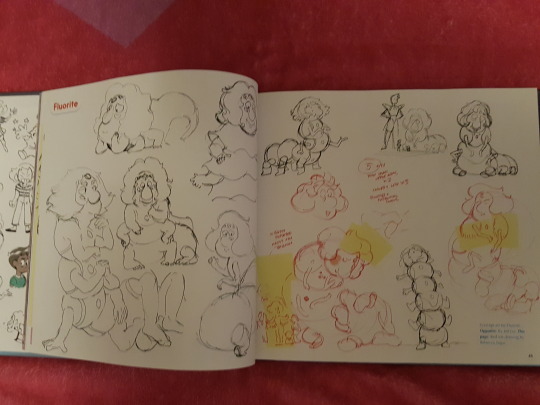
And there's also a spread of "the two sides of Steven's life: Gem Magic and Rock N Roll" featuring Sadie Killer and the Suspects (referred to as "Buck's band")--as well as a cool "Crew Cameos" key and some concepts for short-haired Connie.
And then there's some more "finished" art with stills alongside concepts, including some background art, revision, and really cool "fairytale" art from some of the shadowplay storytelling bits. We get "Lars of the Stars," "Jungle Moon," and "Can't Go Back."
2. THE BEGINNING OF THE END: A SINGLE PALE ROSE

In discussing the huge reveals and Gem mysteries in the show, the pacing is examined, and emphasis is put on the intended "slow burn." One of the most difficult things in the show was to strategize so that every piece that was needed to support another piece in the future was placed properly to seed what it was supposed to.
Some of the ideas they developed were more of a group effort and were fit together collaboratively (like Amethyst's being younger than the other Gems and Jasper being from Earth), while others were intended from the beginning based on Rebecca's vision (the fundamental idea of Pink Diamond's true identity, for instance, as well as Obsidian's design and sword and our Pearl not being Pink's first).
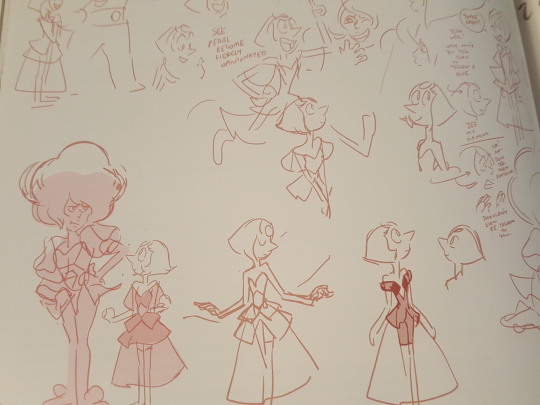
The writing process gets a great deep dive here, including fun tidbits like how the orb in the moon base was inserted by Joe Johnston and they literally had no idea what it was for when they wrote the episode. They repurposed it when they figured out what they needed.
Rebecca credits her detailed timelines for helping keep the order straight, and discusses how other artists are sometimes flabbergasted that a storyboard-driven show can have this much detail and continuity and yet not get wrecked by the free non-scripted boarding process. But Rebecca and the Crew valued that approach and loved the way fresh eyes would handle an idea, making it come back alive, entertaining, vivid.
Several Crew members weigh in on the writing process. Lauren Hecht refers to making lots of incorrect guesses despite being on the inside. Joe Johnston recalled getting briefed on his first day and getting so excited to start working on this massive project.
Miki Brewster remembered being told Rose Quartz is Pink Diamond and being shocked--and also confused about why Ruby and Sapphire would need to be married if they're already basically married. Drew Green talks about being brought in late and getting to watch unaired episodes and a rough of the movie while eating cereal.
Ian Jones-Quartey complains about Pink Diamond's real jester-like form being leaked to the internet through a Hot Topic shirt. Rebecca piggybacks on that and says it was upsetting that the wedding was leaked because of toy fair keychains featuring Ruby and Sapphire in wedding attire. They'd always be worried about leaks, and sometimes Rebecca struggled not to talk about the reality of Pink Diamond before the reveal because she knew it would make so much more sense once the truth was out. And everything associated with Rose makes more sense once you know she's Pink--especially what happened with Bismuth, considering what we know about how Pink Diamond has a habit of treating anyone who no longer serves her interests.
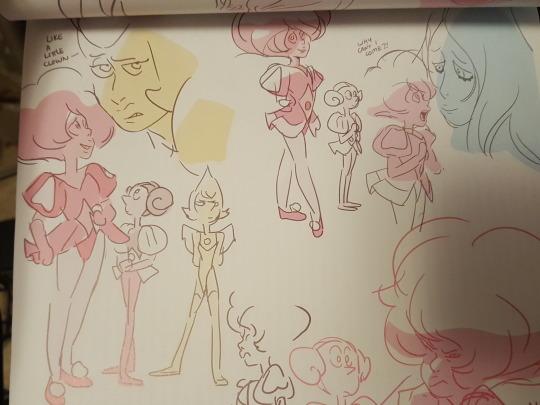
When it comes to visual cues, Rebecca also talks about intentional designs to create a feeling of unity between concepts, like the flower shapes on Pink Diamond's palanquin lining up with the poofs of Steven's hair and the star imagery of the series. Steven Sugar and Mary Nash discuss how the Human Zoo incorporated this imagery, trying to look like Homeworld with a Pink Diamond touch.
Steven Sugar, as a game nerd, liked to throw in video game references from old and modern stuff to feel like he's inserting what he's enjoying and who he is from moment to moment, while Mary Nash, who related to Sadie as a basement-dwelling young person with cult interests, liked to include stuff from MST3K and cult movies. Pearl's hand gestures get a spotlight too--her reflex to cover her mouth when Pink Diamond was being discussed was analyzed here.
A "Top Secret Visual Timeline" from 2016 is included which tells us some Diamond history. It has an earlier version of Pink Pearl's fate and does not include Spinel since the movie hadn't been greenlit. The timeline includes the birth of the Diamonds, the emergence and major story beats for each major character, and some philosophy of the driving force behind each.

We're told that Pink Diamond straightened up, behavior-wise, after she lost her first Pearl, and that Yellow and Blue wanted to give her a planet but White only agreed to it to prove she would fail at managing a colony. Pearl, meanwhile, is so confused to have a Diamond who keeps asking her what she thinks when she doesn't believe she should have opinions.
And when Pink moonlighted as Rose to start conflict, she found herself leading an army to fight Pink's troops--then Yellow's, and eventually Blue's too. Lapis is said to be waiting for the conflict to end on Earth so she can terraform, but she gets trapped instead.
Pearl's love story with Rose is described as "an endless honeymoon" where she's free to love her, while Rose's is more like "I'm now the head of the family and I'm going to give everyone what they never had, so everyone is super special!"
Jasper is described as "adopted" into Yellow's army as the only successful Beta Quartz. And White Diamond knew that Pink Diamond was not dead--she thought she was just running away from home like a brat and would eventually be back.
3. THE HEART OF THE CRYSTAL GEMS

Now we discuss Rose Quartz--the original Pink Diamond. How she was selfish and selfless, never enough and always too much, and how Greg was her first partner who "challenged her" to be an equal. Rebecca describes Rose as being delighted by the idea that both she and Greg reinvented themselves, but when that leads her to want to share her past, Greg isn't interested--he only wants to know who she is now, and doesn't consider the old her to be her.
Rebecca likes Carl Jung's concept of "enantiodromia," which is the idea that extremes lead to their extreme opposite. This is demonstrated in all of the Diamonds. This narrative is interspersed with drawings of Greg and Rose being cute.
But another "heart" of the Crystal Gems is its relationships--particularly, Garnet, the fairy tale romance embodied. More psychological theories are discussed with regard to differentiation in a relationship making the relationship stronger, and how they made sure that happened for Garnet during the appropriate arc. Rebecca has struggled with the idea that she, like Ruby, went straight from a "family" group to a living-with-others situation and never lived by herself. But she also learned that you can in fact develop as a person in the context of a relationship--you don't have to be alone to do it. Ruby learned that too, and chose on her own terms to be with Sapphire.

The wedding made so much sense to Rebecca and the crew that they couldn't imagine a wholesome couple like Ruby and Sapphire not having a wedding episode. They wanted it for years: The wedding concepts always included the tuxedo for Sapphire and the wedding dress for Ruby.

But pushback (often blamed on the conservative standards of the international market) led to negotiations trying to keep Ruby and Sapphire's relationship from being explicit. Rebecca and the Crew were very tired of this double standard, and they were especially irritated by attempts to claim a wedding wouldn't be well received by a core demographic or wouldn't make sense for Steven's character. But other shows had done weddings and Steven had been established to love weddings already.
Rebecca kept adding more elements to the wedding episode to answer all the concerns, but she didn't want to back down from explicit marriage between these characters. They deserved it. And the audience deserved to see this as wholesome, like any other cartoon wedding. Eventually they got their way and were allowed to have the wedding. But the ordered episodes were also coming to a close without promise of more, so Rebecca had to request more episodes to be able to wrap up the storyline!
And of course, there is Steven, the true heart of the team. A very interesting aside discusses Garnet's leadership and how the network pushed the Crewniverse to acknowledge Steven as the leader. This was successfully resisted throughout as well--because Garnet is the leader (unless she's incapacitated, of course). It's fantastic that this concept was preserved because too often a young male chosen one is elevated above people with more experience and knowledge because of that chosen one tradition, so it's really nice to have a show acknowledge that team leadership is more appropriate for an adult.
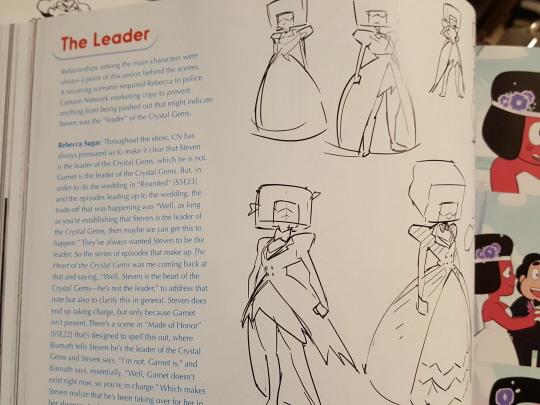
4. ERA 3

Beginning with a discussion of the Diamonds, this chapter deconstructs the dysfunctional "family" of the Diamonds (who are said to be based on tropes about evil stepmothers and stepsisters), with the thread of dysfunction originating with White Diamond.
Yellow is physical, Blue is emotional, White is judgmental, and Pink is impulsive. Some philosophy on why Pink is naturally manipulative and why she clashes so much with White is offered.
White believes her identity is to be imposed on all because she is the pinnacle of what should be--and therefore, she has the right to make decisions and statements about and on behalf of everyone. But her secret is that she can't do what the others do--act or feel or want. In trying to be everyone, she is no one.
And this becomes very important when she confronts Steven about his identity and turns out to be wrong. The triumph of Steven being totally, fully himself is a beautiful, simple revelation that's described as far more satisfying than the theories about Pink living inside him or Rose returning from his Gem.
Also discussed is Gem architecture. A lot went into this idea, and Steven Sugar weighs in to say he had to think of what it would mean for a world to have buildings but serve no human needs. That's why it's mostly focused on transport and storage. Even the broken planet is meant to indicate a place stripped for its resources, and everything serves a function that is meant to avoid looking like the human equivalents.
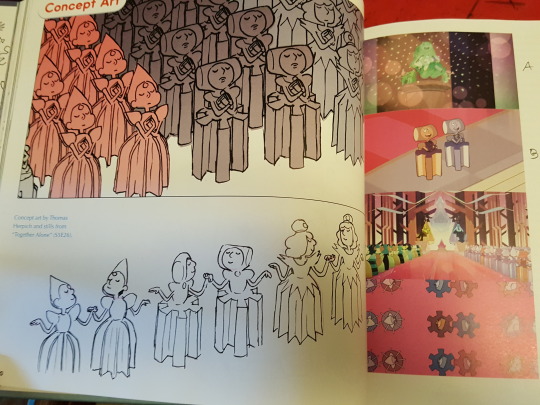
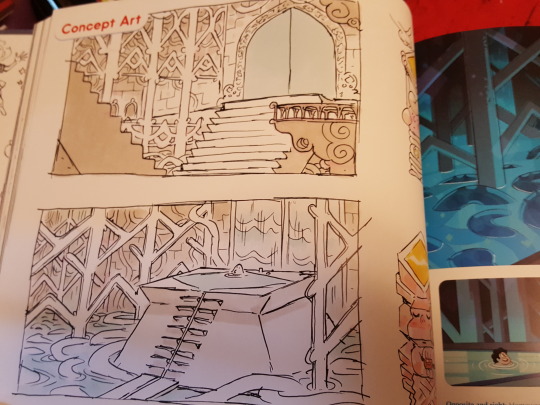
And there's another layer, too: a difference between Era 1 and Era 2. Era 2 became more functional to hide Era 1's broken bits, and older Homeworld buildings still have some "ornate and ancient" feel to them. And the fact that props, tools, and even walls and doors could be living was taken from a concept Rebecca thought was horrible from old Busby Berkeley movies, where people were inanimate objects and it was portrayed as lovely. Tom Herpich helped conceptualize these living objects.
Steven dealing with "princess tropes" is discussed here too. The Pebbles (worked on with Pendleton Ward) were sort of his Cinderella's mice, and all the locked-in-a-tower, having supportive tiny friends help you, getting princess clothes made, attending a ball, having to mind your manners stuff was intentionally related to fairy tales.
The point of doing that (besides fun) was to easily invoke the feeling that Steven was being made to be someone he's not, and that he was being treated like THIS is who he really is when it isn't. White Diamond as the "evil stepmother" is discussed with regard to her detailed features and massive scale. They generally didn't put fingernails and eyelashes on characters (especially not to indicate that they were women or girls!), but they decided White would get all of these feminine markers for tradition's sake.

Rebecca also invokes several other references that were included and describes the princess tropes as "chipping away at his integrity" setting him up for the final challenge with White.
There is again tons of concept art: Homeworld architecture, Pebbles, Diamond diagrams, background Jades and Lemon Jade Fusion, Comby, Diamond extraction chambers, and White Diamond.

5. CHANGE YOUR MIND

Now we finally begin to discuss Steven's identity. The "Perfect Steven," discussed in several interviews before this book's release, was an idea back in 2013; the "ultimate Steven," beefed up and shonen-looking, was far from perfect because OUR Steven is perfect, while this alpha hero Steven idea (used in Steven Universe Future) didn't belong being idolized in such a show.
They thought about having Steven fall apart into organic half and Gem half early in the show (during "Giant Woman" after a successful fusion and unfusion, even!), but they didn't try the concept until the last episode. They didn't want the "Pink" Steven to be portrayed as "better" even though he would be more powerful, so they decided he isn't whole without his organic self and he's just as much of a shell as the organic half. They absolutely did not want any ending that required Rose to be inside him or waiting to come back. But the debates were fierce--what DOES it mean to have Rose's Gem?
Ian Jones-Quartey brings in an anecdote about his own family to emphasize some of the immigrant themes that inspired aspects of the show. He had a brother who reinvented himself elsewhere away from family without resolving issues, and all the ramifications of that were explored in the show through Rose Quartz. (He is careful to say he doesn't think his immigrant experience is like being from another planet!) But he did say you can hurt your old family even if they were toxic or didn't know the real you, and you can hurt your new family by hiding your past. The Pizza family of course was also a more direct reference to Ian's Ghanaian family.
In talking about the new Fusions from this episode, Sunstone is largely described by Miki, who also got to board the Sunstone section. Sunstone was described as a cool 1990s character and the evolution just continued into making them a fourth-wall-breaking PSA dispenser. Obsidian is also discussed, with their sword being an early concept. Steven Sugar said they totally knew it would be forged in action. Obsidian being similar to the Temple design is of course another very early detail.

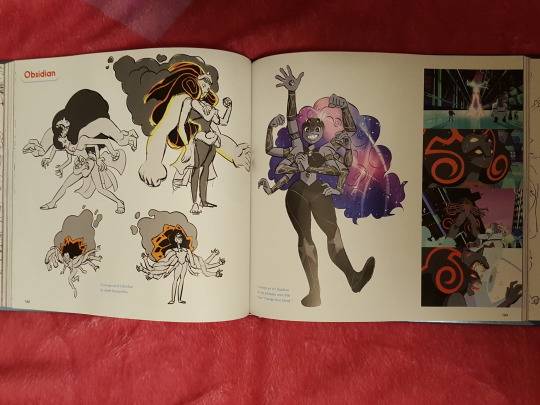
The story of how James Baxter got involved with one of the final scenes (Organic Steven and Pink Steven fusing in front of White Diamond) was shared. His family was fans of the show and Rebecca Sugar took the time to drive to a birthday party for his daughter and give her a drawing. He then owed her a favor, and this was it.

Concept art is again included, this time with sample boards, promo images, a Diamond fight concept, costume design changes for the Gems, new Fusions, the so-called "Mega Diamond" ship conglomerate, some scenes from the White Diamond confrontation, Pink Steven, multiple pages of James Baxter animation, corrupted Gems and their healed selves, and photos from the "Change Your Mind" premiere and some awards. The show has won one design-related Emmy, a Peabody Award, and a GLAAD award.
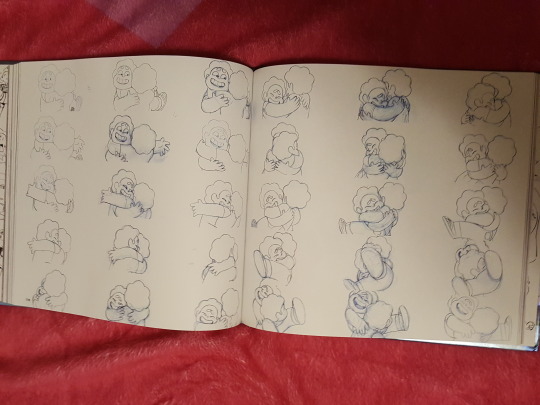
6. STEVEN UNIVERSE FUTURE
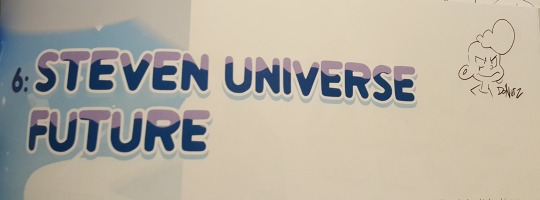
The book doesn't cover the movie because it got its own book, but dives right into Future. Ian Jones-Quartey emphasizes that the movie and Future are separate and different from the original show, which ENDED. After all, after that, Steven has a neck!
Some new names are invoked now: new writers Kate Tsang, Jack Pendarvis, and Taneka Stotts. They were excited to have Steven make HIS OWN mistakes instead of trying to clean up someone else's! Now, instead of doing the usual shonen anime thing and having the final battle be a big physical rumble, Steven has to make peace with himself and take an active role in coping with what all the fighting has done to him and what effect it's had on who he is (and who he wants to be). There is no sudden "I love myself!" answer, either. It's always a process.
Drew Green and Maya Petersen, who came on board as storyboarders officially in Future, also weighed in on writing for a "mature" show, how to deal with Steven being a "moral compass" while being sort of unreliable, and what they learned as Crew that they didn't know as fans. Drew didn't know Garnet never asks questions. Jack didn't realize the show never deviated from Steven's point of view. Taneka was nervous but excited to collaborate. Kate was worried about how established the show was and what to do as a new writer to contribute appropriately.
Maya was on the old Crew but not as a storyboarder, so felt like some of the "old" ideas ended up not being appropriate for the "new" Future in an embarrassing way--and dreaded the idea of dealing with Steven's emotional problems when they were similar to stuff she'd been through. She also was personally behind the idea of Steven wanting to dump his problems by becoming Stevonnie, and got to work with Etienne Guignard on inventing the Pearl creation backstory with Volleyball.
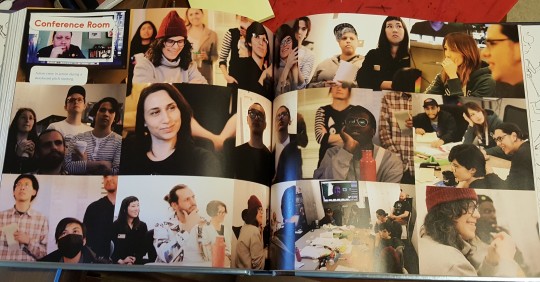
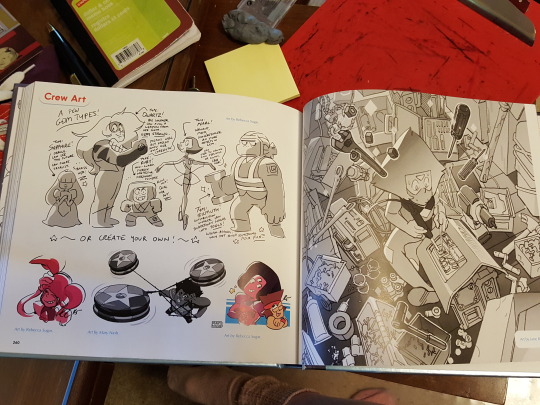
There's some discussion of "depression hobbies," stress, and the show's pacing. And they say Etienne was entertaining at pitches. There's even some discussion of how Greg is taken off a bit of a pedestal because his terrible restrictive life in the suburbs sounded wholesome to Steven and Greg presented it negatively.
And then there is some information about how the Crew felt behind the scenes due to fan reactions and negative press. Ian discusses feeling offended when the Black characters are described as bad examples, as if their cartoonized but realistic-in-context features are automatically caricatures.
Rebecca Sugar felt beaten down by some of these narratives and began to access mental health services, inspiring some of the content of "Mindful Education." A long reflection from Rebecca discusses people's infighting about her show and what she had a responsibility to show or not show in the story. She learned a lot about bullying from Cartoon Network's anti-bullying program and learned that bullies thrive on whatever attention you give them--unless it is made clear to them by a peer group that no one is impressed by their cruel actions. Also, not all negative feedback is bullying. Constructive criticism is different. Self-awareness can help you avoid internalizing what bullies might do or say to you.
Segueing from the discussion of how people are affected by and connect with the show, we then discuss how they chose as a team what should be covered as the show came to a close. They didn't have time to do quite a few stories they wanted time for, like a Rhodonite story, a Lars side story, and Diamond "prehistory" and religion; all of it was put aside for the main arc with Steven.
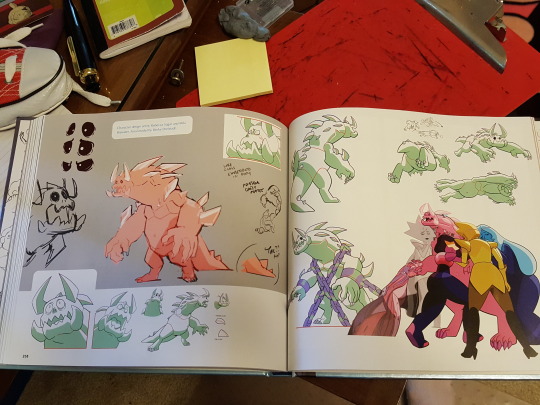
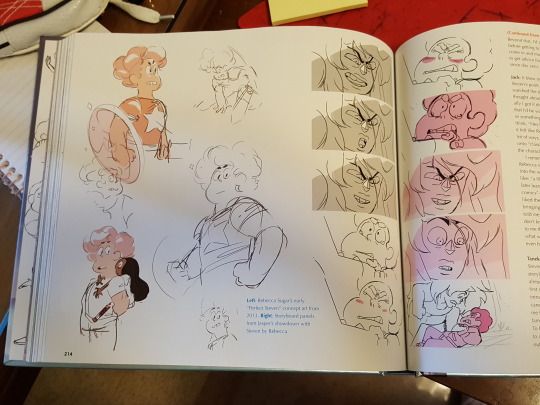
They thought people would find those stories about Homeworld and Off Color history very interesting, but so much of the show had been about Steven's Gem adventures, so keeping him mostly on Earth seemed appropriate. The acknowledgment of his battle damage, of his trauma, was necessary and real, and helpful in an important way to the core audience.
Oh, and there was some stuff about a cheeseburger tree. Don't ask.
In discussing the "reverse escapism" of the original show (Gem aliens are intrigued by everyday human culture, and realism is necessary), Rebecca says her views have changed on escapism and gets why some people want a soothing feel-better show. She acknowledged also that her own escapist dreams-come-true fulfilled in the show didn't feel like escapism because they were givens to the majority of mainstream culture, but were never guaranteed to marginalized people.
Rebecca ties in her several-times-told story about "Love Like You" and how the middle bit was when she didn't feel she was worth looking up to, and the realizations she had to tie the beginning to the end. Feeling like someone will like you less if they know you more is terrible. So sometimes a show like this can be helpful in telling people that they belong when their fantasies are things like "I want to be loved" and "I want to know I exist."
In Future, Steven has to connect to who he is and love that person--and understand that person enough to finally feel that even if he's not fixing their problems or saving their world right this second, Steven deserves his family's love and support, and they WANT to give it to him.
There's a huge amount of supplemental material in this section so there's no way I could name it all. The charts for Future's timeline are pretty straightforward, though a few episodes like "A Very Special Episode," "Why So Blue," "In Dreams," and "Bismuth Casual" aren't specifically represented and a couple are in a different order ("Prickly Pair" was conceived as happening after "Fragments" and "Homeworld Bound").
Steven feeling like a monster, having intrusive thoughts, having not forgiven the Diamonds, and getting help/moving on--it's all there.

We have keys, color scripts, and boards for the new opening and some various backgrounds and storyboard art from episodes. Model sheets for Shep, Nice Lapis and Mean Lapis, Jasper, Steven Tag Gems, Pink Steven Powers, Monster Steven. New house concepts, Era 3 Homeworld concept art for the Diamond environments, and background art for the Reef.
New Connie and Greg designs. Concepts for Mega Pearl, the Rose Quartzes, Bluebird, and Morganite (who didn't get used). And there are some photos from recording and the conference room. There are even some extras from "Crossover Nexus," the crossover with OK K.O.!--including an unused cut scene that included Ruby and Sapphire fighting. The rest of the book is a bunch of adorable Crewniverse art--extras, blog drawings, promos, and gifts to each other.
NOTABLE
1.
The first timeline chart in the book features a cool sketch of the original Off Colors, which at the time this planning document was drafted included unused Off Colors Flint and Chert.
We knew of their existence already because of an episode of the podcast, but these two unexpectedly appeared as incidental characters in the Steven Universe Future episode "Homeworld Bound," identified only in the credits. Sad to think that instead of banding with the Off Colors, these two were probably shattered for their crime (being Quartzes who don't want to fight) and that's why we see them being repaired in this episode. Later, there's some brainstorming for types of Off Colors and "a Ruby that wants to wear limb enhancers" is mentioned as well.
2.
It looks like there was also originally more juice to the story of tracking down the events of the war culminating in Pink Diamond's assassination.
One of the timelines talks about Steven thinking it makes sense that Pearl can't talk about her involvement because she might have been a double agent, explaining why Rose Quartz always knew what Pink Diamond was doing. It seems like that bit was supposed to be included in Garnet's version of the story she believed in "Your Mother and Mine." Seems like they originally conceived Garnet's story to inspire the Off Colors to become pirates and freedom fighters, though in the show's canon this storytelling happened after Lars had already reinvented himself the way he did.
Sadie was also supposed to be sending letters to Lars via Steven, which is funny since the "Letters to Lars" episode is just a montage Steven letter. And of course it's specified that Steven was supposed to get Pink Diamond flashbacks by going to the Palace on Homeworld.
3.
The second chart in the book makes references to Sadie's reinvention of herself as a parallel to Lars, Greg, and Pink Diamond all doing the same thing, and how positive it is to embrace such a thing--a version of yourself that YOU create.
I love that Yellow Diamond's arm ship arm-wrestling the Cluster was always part of the plan.
There's some more explicit direction to have Connie help Steven understand the Diamonds as "strict parents," and a lot more emphasis on everyone realizing Rose had been inspired by THEM rather than them all following her.
White Diamond is presented here as if she thinks of Pink Diamond as a "daughter" (whom she now understands she has "lost"). There are notes on how the Diamonds have a responsibility to their children and should attend to it before just continuing to make more.
4.
One of the concept art images for the Off Colors features Rhodonite crouching by Padparadscha saying "Don't worry, I won't let them hurt you." It's very interesting because she DOES seem to protect Padparadscha in the show, but doesn't seem confident about it in her final version, even though it does seem like she'd be "programmed" to guard aristocratic Gems because of her Ruby and Pearl makeup. Cool.
5.
A "Crew Cameos" spread was included, which is of great interest to some of us who loved seeing the Crew insert themselves into the show. Not every SU Crew person who's been represented in a crowd was there, but this crowd included Amish Kumar, Kat Morris, Amanda Winterstein, Angie Wang, Lamar Abrams, Emily Walus, Mary Nash, Joe Johnston, Christy Cohen, Danny Cragg, Hilary Florido, Danny Hynes, Matt Burnett, Ben Levin, Elle Michalka.
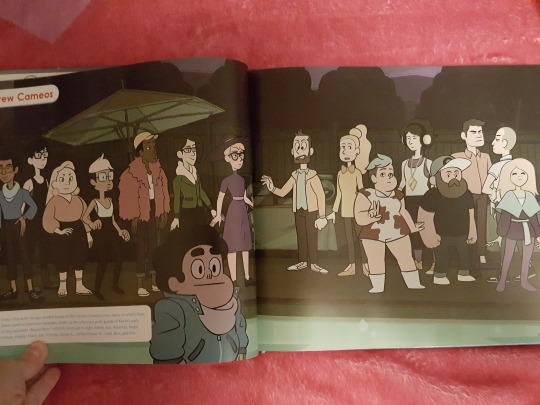
6.
The official national flower of South Korea, Hibiscus syriacus, is the name of Pink Diamond's flower.
7.
One of Steven Sugar's comments about the silhouette difference between humans and Gems points out that humans have ears. This seems to be pretty good confirmation that they are not supposed to have ears, despite that sometimes we'll see ears drawn on them in some frames.
8.
Rose Quartz/Pink Diamond is characterized in this book as "self-hating" in a really interesting way, saying that because she believed she was not capable of compassion, she practically worshiped those who demonstrated that ability and thought they were so much better than her--which is described as "intoxicating" and resulted in others being drawn to her. How interesting is that!
9.
Timelines reveal that early plans for Pink Diamond's first Pearl originally had her getting destroyed by Pink during a game, and then her destruction was rewritten as a punishment from the Diamonds after Pink Pearl defended Pink Diamond to the other Diamonds. They went back to the idea of her getting hurt by Pink for the final version, though the cracked face and control by White Diamond was not on the agenda until they started writing "Change Your Mind."
10.
The approximate ages of the major characters, based on emergence, are revealed on these timelines. It begins with a cracked-planet-looking graphic depicting four tiny Diamonds emerging at 20,000 years ago. Some suspicious "blacked out" redacting surrounds a long timeline tail that goes back before that, which may mean there are secrets they still don't want to reveal. But the dates go like this:
20,000 years ago: The Diamonds emerge.
11,000 years ago: Pearl is custom-made for Pink Diamond.
8,000 years ago: Sapphire emerges (on Homeworld).
6,000 years ago: Ruby emerges (on a colony).
5,750 years ago: Garnet is formed.
5,600 years ago: Lapis is poofed and put in the mirror.
5,200 years ago: Jasper emerges (on Earth).
5,050 years ago: The Cluster is planted.
5,000 years ago: Amethyst emerges (on Earth).
4,500 years ago: The Crystal Gems found Amethyst.
3,000 years ago: Peridot emerges (on Homeworld).
40 years ago: Pearl found Lapis's mirror at the Galaxy Warp.
And of course we know 14 years ago Steven is born!
11.
Originally the Diamonds were based on a quartet of themes: Love, Fear, Pride, and Sorrow. It got too complicated to keep and it was abandoned, with Pink's identification of "love" being described as "particularly outdated."
12.
Notes on a sketch say that Pearl was inspired to become bold and unashamed because Pink's questions drove her to have opinions, and it's said that Rose "fell in love" with her boldness.
13.
Rebecca tells the story of driving off a ridge and getting stuck in the desert, comparing this to Ruby's tumble during her Wild West adventure and using it as inspiration. She's told this story before but here it is in print. She also included the story about using the flowers from a friend's wedding to put in Ruby's hair.
14.
Rebecca describes having to "fight" notes she was given when it had to do with Ruby and Sapphire's relationship. One she describes as NOT fighting was for a signing card depicting Ruby and Sapphire dancing. It was called "too romantic" and she decided not to worry about it since it wasn't the actual show content.
She was also scolded over her book The Answer because the powers that be expected her to downplay that relationship. She always argued that queer youth deserved these things.

15.
Tom Herpich describes being inspired to name Blue Diamond's comb "Comby" because he was watching the news about Comey getting fired from the FBI. It's also a mineral-related term and I always assumed that reference was intentional, but maybe it's not and this is the only intended significance to Comby's name?
16.
Rainbow Quartz 2.0's design is not discussed, though the other two new Fusions from "Change Your Mind" (Sunstone and Obsidian) were. RQ2 has some sketches included, but no accompanying narrative in the text.
17.
A sheet of corrupted Gems and their healed selves is offered, though it doesn't appear to be final. The obelisk in "Serious Steven" is labeled Albite. The unnamed Worm Monster, Desert Glass, and Watermelon Tourmaline are included. An unnamed birdlike Gem represents the Big Bird monster from "Giant Woman." The crab monster from "Arcade Mania" is labeled Blue Chalcedony. The Tongue Monster is drawn uncorrupted but not named. The Flower Monster from "Back to the Kindergarten" is labeled Grossular Diopside or Titanite. The invisible monster from "Island Adventure" is labeled Moonstone. The Lighthouse Gem is labeled White Topaz. A form for Larimar that was used in "Change Your Mind" but changed in Future is there. The Slinker is listed as Chrysocolla. And the Crab Monster is listed as Aventurine.
On the next page, this is changed to Bixbite (as it was in Steven Universe Future), and we then also have Lace Amethyst, Blue Lace Agate, Crazy Lace Agate (Fusion), Ocean Jasper, the Mother Centipeetle Nephrite (Facet 413 Cabochon 12) and three other Nephrites, Angel Aura Quartz, a hooded Jasper, Zebra Jasper, Biggs Jasper, Watermelon Tourmaline (labeled as Fusion of Gem * Onion--huh?), Snowflake Obsidian, "Little" Larimar, and Orange Spodumene (who was the Worm).
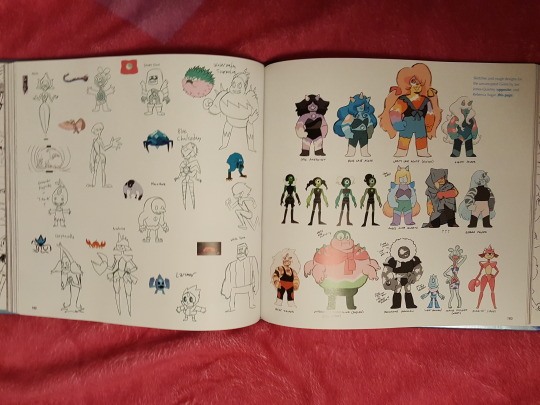
18.
The Rhodonite side story would have been about the love story of a Ruby and a Pearl working for Morganite. Images of Morganite and her servants, unfused, are in the book. We do not get this additional information, but Rebecca said in a panel shortly before the book's release that Rhodonite's story would have been about finding out that she had been Rejuvenated 17 times because her components kept falling in love and needing to be reset.
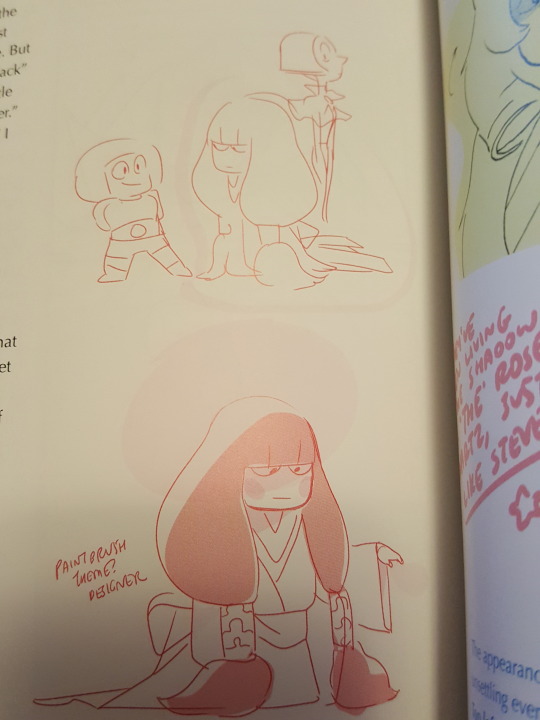
19.
Referring to the Diamonds on one of the charts, Steven's perspective is "I can't believe I helped these" and then there's a censor bar. Welp.
20.
Some included art by Hilary Florido features Kevin with a souped-up Koala Princess car and another where Kevin is staring at himself in the mirror in front of an altar to himself.
21.
Rebecca's sweater collection is included in the Crew art.
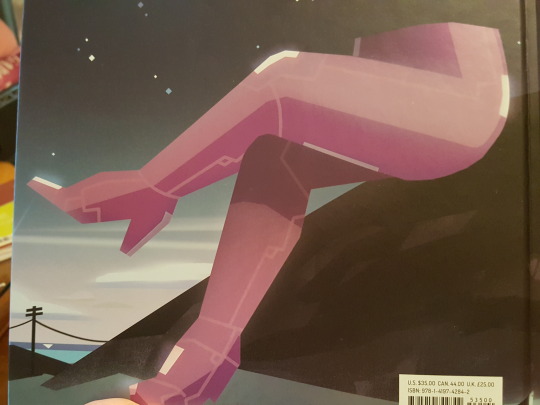
[SU Book and Comic Reviews]
159 notes
·
View notes
Text
I’m back from my rock show! Who wants to see all my new Cool Rocks?

This little guy is red corundum, also known as a ruby! It naturally grows in that hexagonal shape. Here’s a fun rock fact: if this corundum was any other color, it would be called a sapphire!

I’ve gotta get some sunlight shining on this one. It’s the only way to properly appreciate rutilated quartz! This super clear quartz has a whole forest of golden needles of rutile growing inside! The only bad thing about rutilated quartz is that photos don’t do justice to how sparkly and golden and amazing it really is.

This is half of what’s called a pyrite sun! Pyrite’s known for its cube-shaped crystals, but did you know it can form in flat round disks like this too? They’re also called sun dollars, and pretty much the only place in the world where they occur is my home state of Illinois!
I won this rock at the show’s silent auction, and somebody else went home with the other half of the disk. It’s cool to think that somewhere out there, someone has the other half of my rock.

Here’s some more pyrite! These pyrite crystals didn’t form in the usual cube shape either. They’re slightly rarer dodecahedral crystals! Those pointy white crystals growing around them are a mixture of calcite and dolomite. The other cool thing about this specimen is the beautiful bronzy reddish color of the pyrite, which was probably caused by oxidation, the pyrite chemically reacting with oxygen.

Opal! Opal opal opal!! It’s about the same size and color as a piece of chocolate, which is fitting because this is Ethiopian chocolate opal!

The play of color is amazing against that dark background. Here are some more pictures of all the different colors in this opal. I’m particularly blown away by that blue!
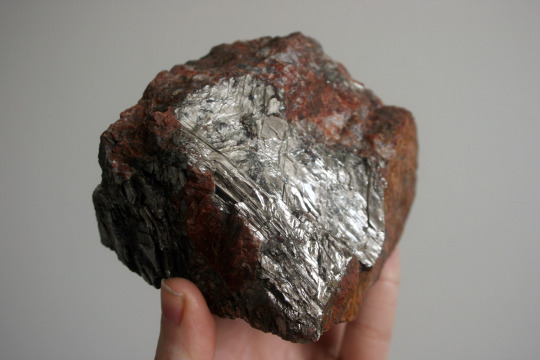
This is pegmatite, an ingneous rock. Igneous rocks are the rocks that form when molten lava cools and hardens, and pegmatites are igneous rocks which form with abnormally big crystals. Usually crystal growth happens really slowly, but the crystals in pegmatite are able to get really big because they form really fast! I didn’t wrap this rock in tinfoil. The huge shiny patch on this pegmatite is probably either molybdenite or graphite - the stuff in pencil lead!
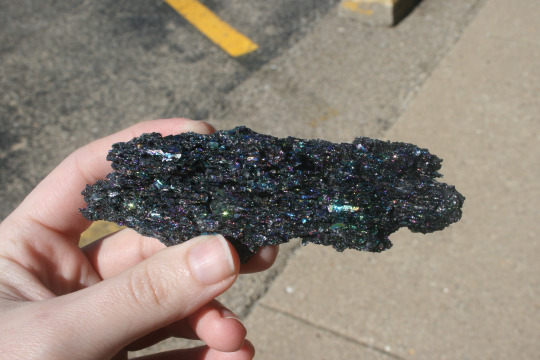
How about a manmade rock? This is silicon carbide, also known as carborundum! It’s created by heating carbon and silica and is used for all kinds of things - like an abrasive for saws and cutting tools. I own a dremel with some silicon carbide bits! Of course it also makes for an amazing iridescent gemstone.
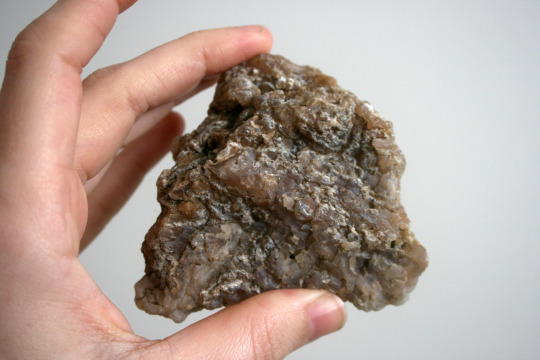
This weird looking rock is chalcedony! And it’s cool because it’s very slightly sort of technically radioactive!!! My little rock viewing light isn’t powerful enough for this kind of fluorescence, but if I had the right kind of UV light, I could show off how this guy fluoresces neon green! Green fluorescence in chalcedony is caused by uranyl ions… as in uranium!
Don’t worry, this rock isn’t radioactive enough to hurt me. Lots of quartz, jasper, and chalcedony contain tiny amounts of uranyl ions, but uranium’s actually pretty safe stuff! Even solid chunks of uranium ore are safe enough to hold in your bare hands. I got to handle some at the rock show!
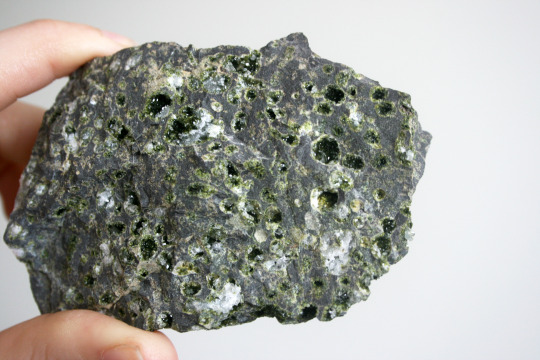
This rock is full of tiny, hollow pockets lined with green crystals of epidote. Epidote has some Cool Optical Properties, but these crystals are much too small to show them off. Supposedly, large crystals of epidote change color depending on the angle you view them! But this rock has sparkly green spots, and that’s enough to file it under Rocks That Make Me Happy!
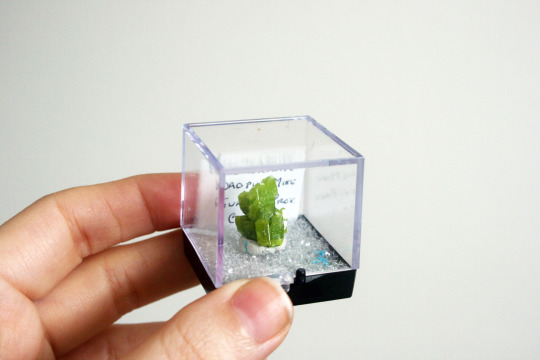
Speaking of green rocks, this is pyromorphite! I’d never even heard of this rock before going to the rock show, but it’s my favorite color, so this is my new favorite rock! Here’s all the Cool Science I’ve been learning about it.
This specimen came from Daoping Mine in China, which produces some really large, beautiful crystals of this stuff! Pyromorphite is a type of apatite, so it’s like the sister of the blue and yellow apatite specimens I already own. It’s a lead ore, so if I ate it, I’d be super dead! Pyromorphite can actually form in the soil of industrial areas which are polluted with large amounts of lead. Some scientific studies have been done about maybe using that transformation of lead into pyromorphite as a way of cleaning up polluted soil by making the lead safer and less water soluble. But it turns out that’s not a good solution, because there’s a species of fungus that likes to turn pyromorphite back into lead! That fungus is black mold, the same stuff that makes you super sick if it starts growing in your house. Geeze black mold, why are you so terrible in literally every context?
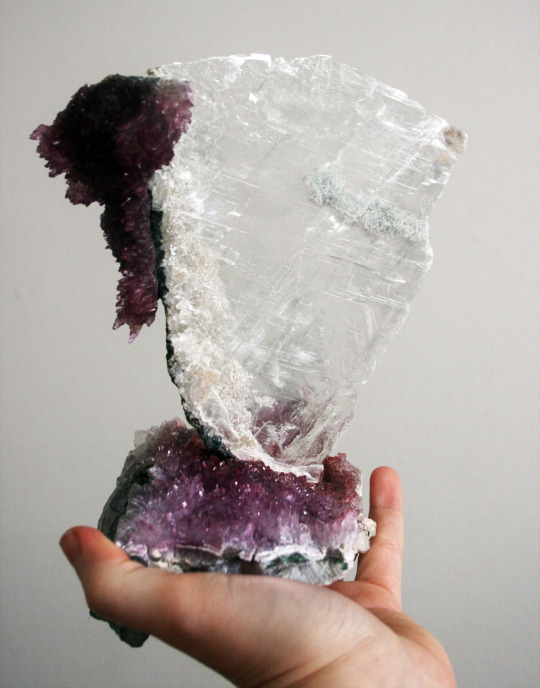
Big sparkly girl! Big sparkly girl!! This is probably the second best rock I came home with. It’s a big plate of selenite with a bunch of interesting inclusions. (And I cannot resist interesting inclusions.) It didn’t grow out of that piece of quartz; that’s actually its display stand! This Cool Rock is a conglomerate of several different rocks held together by resin - it’s an art piece! The quartz has been dyed purple to made the colorless selenite really stand out against it. If you don’t like manmade rocks, cool displays like this are probably not for you, but I think it’s a neat way of showing off a rock! Sort of like a little rock statue for my apartment.
But now for the best rock…
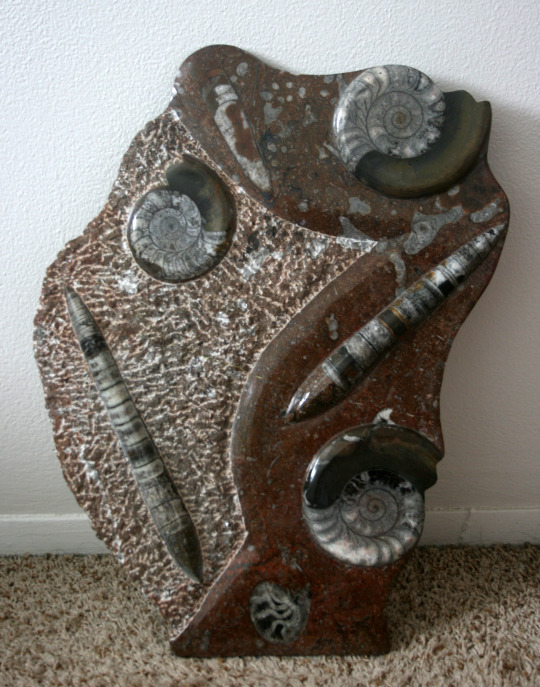
Big fossil boy! Massive fossil boy!! Absolutely enormous fossil boy!!!

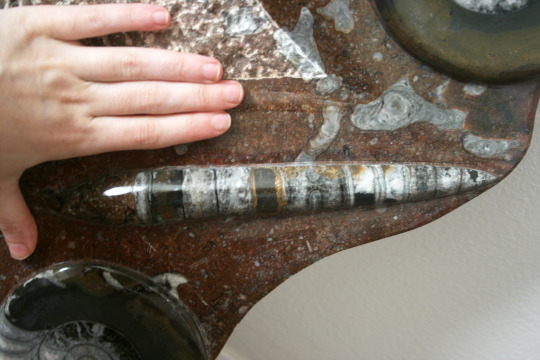
Here is my unreasonably large pianist’s hand for scale. These fossils are huge! Those long cones are the skeletons of orthoconic nautiloids, but you might have also heard of them as orthoceras. They were big cone-shaped cephalopods! They’re found all over the world and actually belong to a whole bunch of different species, though scientists didn’t realize that for a long time and just called them all orthoceras. I’m not sure if the spiral fossils are nautiloids or ammonoids. You’re supposed to be able to tell from the shape of the shell. Nautiloids, maybe?
What a cool find! Nothing is better than coming home from a rock show with a bunch of new rocks! There’s only one problem now.
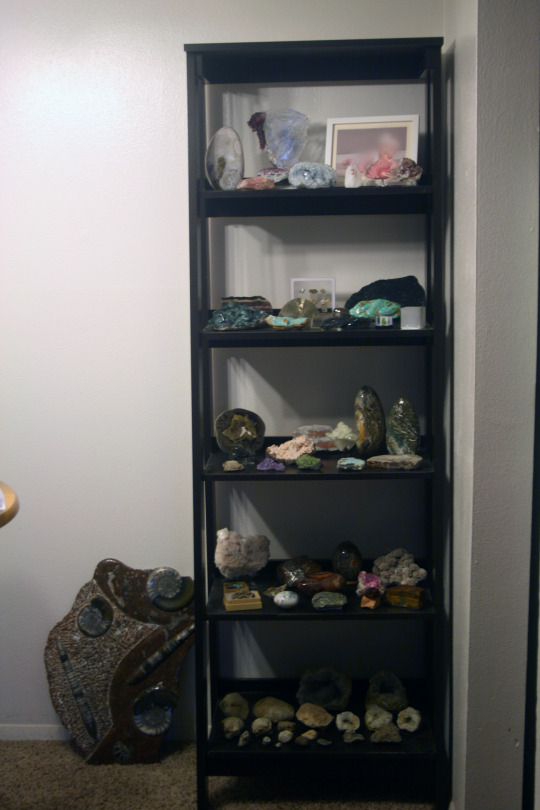
I’m gonna need another bookshelf.
2K notes
·
View notes
Text
Astrarium: The Adventures Between Realms: An In-Depth Look

What is Astrarium: The Adventures Between Realms?
Astrarium is a massive, written work of online fiction created by myself and my boyfriend Jonathan, with the art department fully manned by our best friend Tai (@cowboytai) and edited/possibly narrated by our other best friend Watta (found here at his YouTube channel).
The story follows the adventures of Artemis, or Ari as she's better known, a human girl raised by Dragons. The Dragons of are the deities of the universe, with a select group delegated to the task of Watchers, whom take the role of nurturing, shaping and recording the histories of the Seven Realms found in their universe. Ari, at age 16, is able to begin her training to become a Watcher (and the first ever human Watcher), and takes the four years of her training to explore each and every Realm, making friends and enemies along the way, and discovering more of who she is and who she wants to become.
We're currently looking at publishing it on its own website sometime in 2022. What we're looking at having done before then is the prologue, first five chapters, and the first trips to every Realm. Currently, we have the prologue and chapters 1-3 finished, with chapter 4 in progress along with the first round of trips. The prologue and chapters 1-5 will be posted together on the launch of the website. We will also have a Patreon set up for it, with some varying reward tiers!
What are the Realms?
There are Seven Realms featured in Astrarium, all named after constellations. They are Hydra (The Water Serpent), Auriga (The Charioteer), Ursa (Greater Bear), Cygnus (The Swan), Orion (The Hunter), Lepus (The Hare) and Lyra (The Lyre). Each one also features its own aesthetics, cultures, and even specialized races/species of civilized life.
Hydra takes place in a very water and island based world, with an aesthetic setting of the Age of Exploration/Golden Age of Piracy. There are seven major oceans on this world, and hundreds of islands, both inhabited and uninhabited and many filled to the brims with treasures. There are also large underwater cities that are elegantly built and homes to all sorts of academic pursuits.
Auriga is a world inspired by both the Old West and the Steampunk fashion and aesthetic. They have new inventions coming out every day, fueled not just by steam power but also by magical crystals. And they thrive off of having big communities that all rely on each other.
Ursa is a very natural world filled with gorgeous forests and lovely springs. It's world is heavily inspired by high fantasy, dungeons and dragons, and a certain other old tale that'll be evident in its cast of characters. It is filled with magics of all kinds and magical creatures left and right.
The citizens of Cygnus live on floating islands, all connected to each other by tethers, and the inhabitants fly anywhere they please. The aesthetic is based in 1920s/1930s fashion and glitz and glam, with a little bit of a seedy underbelly lurking in the city...as well as interesting horrors down in the jungles below them.
The Giantesses of Orion have kept to the simpler life, with a definite cottage core aesthetic throughout. They are an agricultural society with many settlements and even still wandering nomadic tribes that all unite for the big Games every year.
Lepus' people have been facing an endless winter for over a thousand years. The people have long forsaken and forgotten about their magic, and have relied heavily on science and technology to help rebuild their lives and try to find a way to combat the winter. It's a very sci-fi setting with some style influence from all over.
Lyra is the land of the dead and the home of an eternal party. With plenty of Halloween based influences, there is never a dull moment for those who find themselves in the built towns, and those who are stuck in the fog wander and sing their songs until they find their way to a new home.
Outside of the Realms, there is Dragons Keep, a large mountain in space that acts as the home to all Dragons. It's caves are vast and plentiful, winding all the way through from the head of the mountain, where the High Council meets, to the very bottom. And even with many areas claimed and made use of in this large mountain, there are always mysteries to be found.
Who are the characters?
Astrarium has one of the largest casts of characters we've worked with, with tons of new friends, rivals, and enemies for Ari to meet. Along with Ari, there is a main character for each Realm, with a cast of supporting characters.
Ari (she/her) acts as the main protagonist, helping guide some of the plot and seeing everything through her eyes. On Hydra, our protagonist is Gibbson "Gibbs" Cayde (he/him); on Auriga, Huxley "Huck" Holiday (he/him); on Ursa, Ronan Löx (he/him); on Cygnus, Clyde (he/him); on Orion, Fauna (she/her); on Lepus, Henrietta "Henri" Franklin (possibly she/they, still figuring it out!) ; and on Lyra, Alexei (he/him). Also on Dragons Keep, we have Aris' family, with her adopted mother/Mama, Arabella, her Uncle Killick, and her cousin, Libelle, who is a main character for Dragons Keep.
I hope to get to share more about our supporting cast with you all soon, as they all have some very interesting stories to get to share!
We also are working on art for the main characters as we speak, but we do have Ari's done and that can be found here!
More About The Team?
We're a group of friends who have all known each other since, for the most part, high school! While I'm someone that kind of wants to keep private lives private, I can say that these are the best group of friends to have and we're honestly like our own little family. We've workshopped other projects with each other since, God, like, my senior year of high school? Just about? It's been an insane ride together. We're also just a big bunch of nerds who are all really chill and fun to be around.
How Long is The Story Going To Be?
Astrarium is looking to be the longest project we'll ever do in terms of story timeline, and page count. As the Dragons are masters of time, Ari has the ability to actually mess with it slightly and create what is essentially a "Save point" for herself to go back to after she leaves a Realm. So say she leaves Hydra on a certain day. She can make that save point, go hang out in the other Realms, and come back and it'll be either that exact save point she left at or a few hours later, give or take (though, there are chances of "hiccups" in this, usually occurring when she leaves from Dragons Keep specifically, as it is considered to be outside of the normal flow of time!).
My goal is kind of a fun one of I want it to be one of the longest word count stories out there. I don't really know why I want it to be, other than I think it'd be really cool if I could beat out that Loud House fanfiction in terms of longest works in literature. That's just a nice little goal.
How Can Readers Support the Series?
Honestly, the best thing I can ask for is just getting this around! If anyone takes an interest in this series, reblogs and likes go a long way and are greatly appreciated. We also love, love, love questions!! It's a great feeling to see people want to know more and some questions can really get our thinking caps on to develop more and more! When the site launches, we will again launch the Patreon right alongside it, so if you want to financially support, there'll be reward tiers ranging from $1 a month and upwards! We may look at a Ko-Fi as well and if it looks like people are really interested in it, we may open a merch store and I do want to start releasing some of it as actual books you can have for your shelves!
Financial support is 100000% optional, though, for when that does happen, and like, everyone's situation is different, we just want to make it an option for our audience. But the best feeling in the world to us is seeing people's interest and them sharing it with their friends!
And if anyone has anymore questions, please please please feel free to ask! We're gonna be working on getting to share more updates here soon!! And thank you all for your time!!
#astrarium#astrarium: the adventures between realms#ocs#my characters#my ocs#original story#original works#original writing#writerblr#writing community#writing#fiction#original fiction
26 notes
·
View notes